Everything that you need to know to start your own business. From business ideas to researching the competition.
Practical and real-world advice on how to run your business — from managing employees to keeping the books.
Our best expert advice on how to grow your business — from attracting new customers to keeping existing customers happy and having the capital to do it.
Entrepreneurs and industry leaders share their best advice on how to take your company to the next level.
- Business Ideas
- Human Resources
- Business Financing
- Growth Studio
- Ask the Board
Looking for your local chamber?

Interested in partnering with us?
Run » finance, how to create a financial forecast for a startup business plan.
Financial forecasting allows you to measure the progress of your new business by benchmarking performance against anticipated sales and costs.

When starting a new business, a financial forecast is an important tool for recruiting investors as well as for budgeting for your first months of operating. A financial forecast is used to predict the cash flow necessary to operate the company day-to-day and cover financial liabilities.
Many lenders and investors ask for a financial forecast as part of a business plan; however, with no sales under your belt, it can be tricky to estimate how much money you will need to cover your expenses. Here’s how to begin creating a financial forecast for a new business.
[Read more: Startup 2021: Business Plan Financials ]
Start with a sales forecast
A sales forecast attempts to predict what your monthly sales will be for up to 18 months after launching your business. Creating a sales forecast without any past results is a little difficult. In this case, many entrepreneurs make their predictions using industry trends, market analysis demonstrating the population of potential customers and consumer trends. A sales forecast shows investors and lenders that you have a solid understanding of your target market and a clear vision of who will buy your product or service.
A sales forecast typically breaks down monthly sales by unit and price point. Beyond year two of being in business, the sales forecast can be shown quarterly, instead of monthly. Most financial lenders and investors like to see a three-year sales forecast as part of your startup business plan.
Lower fixed costs mean less risk, which might be theoretical in business schools but are very concrete when you have rent and payroll checks to sign.
Tim Berry, president and founder of Palo Alto Software
Create an expenses budget
An expenses budget forecasts how much you anticipate spending during the first years of operating. This includes both your overhead costs and operating expenses — any financial spending that you anticipate during the course of running your business.
Most experts recommend breaking down your expenses forecast by fixed and variable costs. Fixed costs are things such as rent and payroll, while variable costs change depending on demand and sales — advertising and promotional expenses, for instance. Breaking down costs into these two categories can help you better budget and improve your profitability.
"Lower fixed costs mean less risk, which might be theoretical in business schools but are very concrete when you have rent and payroll checks to sign," Tim Berry, president and founder of Palo Alto Software, told Inc . "Most of your variable costs are in those direct costs that belong in your sales forecast, but there are also some variable expenses, like ads and rebates and such."
Project your break-even point
Together, your expenses budget and sales forecast paints a picture of your profitability. Your break-even projection is the date at which you believe your business will become profitable — when more money is earned than spent. Very few businesses are profitable overnight or even in their first year. Most businesses take two to three years to be profitable, but others take far longer: Tesla , for instance, took 18 years to see its first full-year profit.
Lenders and investors will be interested in your break-even point as a projection of when they can begin to recoup their investment. Likewise, your CFO or operations manager can make better decisions after measuring the company’s results against its forecasts.
[Read more: Startup 2021: Writing a Business Plan? Here’s How to Do It, Step by Step ]
Develop a cash flow projection
A cash flow statement (or projection, for a new business) shows the flow of dollars moving in and out of the business. This is based on the sales forecast, your balance sheet and other assumptions you’ve used to create your expenses projection.
“If you are starting a new business and do not have these historical financial statements, you start by projecting a cash-flow statement broken down into 12 months,” wrote Inc . The cash flow statement will include projected cash flows from operating, investing and financing your business activities.
Keep in mind that most business plans involve developing specific financial documents: income statements, pro formas and a balance sheet, for instance. These documents may be required by investors or lenders; financial projections can help inform the development of those statements and guide your business as it grows.
CO— aims to bring you inspiration from leading respected experts. However, before making any business decision, you should consult a professional who can advise you based on your individual situation.
Follow us on Instagram for more expert tips & business owners’ stories.
CO—is committed to helping you start, run and grow your small business. Learn more about the benefits of small business membership in the U.S. Chamber of Commerce, here .

Become a small business member and save!
Become an integral voice in the world’s largest business organization when you join the U.S. Chamber of Commerce as a small business member. Members also receive exclusive discounts from B2B partners, including a special offer from FedEx that can help your business save hundreds a year on shipping. Become a member today and start saving!
Subscribe to our newsletter, Midnight Oil
Expert business advice, news, and trends, delivered weekly
By signing up you agree to the CO— Privacy Policy. You can opt out anytime.
For more finance tips
What is ai price optimization, what is enterprise resource planning, choosing an enterprise resource planning tool for your small business.
By continuing on our website, you agree to our use of cookies for statistical and personalisation purposes. Know More
Welcome to CO—
Designed for business owners, CO— is a site that connects like minds and delivers actionable insights for next-level growth.
U.S. Chamber of Commerce 1615 H Street, NW Washington, DC 20062
Social links
Looking for local chamber, stay in touch.
- Business Essentials
- Leadership & Management
- Credential of Leadership, Impact, and Management in Business (CLIMB)
- Entrepreneurship & Innovation
- Digital Transformation
- Finance & Accounting
- Business in Society
- For Organizations
- Support Portal
- Media Coverage
- Founding Donors
- Leadership Team

- Harvard Business School →
- HBS Online →
- Business Insights →
Business Insights
Harvard Business School Online's Business Insights Blog provides the career insights you need to achieve your goals and gain confidence in your business skills.
- Career Development
- Communication
- Decision-Making
- Earning Your MBA
- Negotiation
- News & Events
- Productivity
- Staff Spotlight
- Student Profiles
- Work-Life Balance
- AI Essentials for Business
- Alternative Investments
- Business Analytics
- Business Strategy
- Business and Climate Change
- Design Thinking and Innovation
- Digital Marketing Strategy
- Disruptive Strategy
- Economics for Managers
- Entrepreneurship Essentials
- Financial Accounting
- Global Business
- Launching Tech Ventures
- Leadership Principles
- Leadership, Ethics, and Corporate Accountability
- Leading with Finance
- Management Essentials
- Negotiation Mastery
- Organizational Leadership
- Power and Influence for Positive Impact
- Strategy Execution
- Sustainable Business Strategy
- Sustainable Investing
- Winning with Digital Platforms
7 Financial Forecasting Methods to Predict Business Performance

- 21 Jun 2022
Much of accounting involves evaluating past performance. Financial results demonstrate business success to both shareholders and the public. Planning and preparing for the future, however, is just as important.
Shareholders must be reassured that a business has been, and will continue to be, successful. This requires financial forecasting.
Here's an overview of how to use pro forma statements to conduct financial forecasting, along with seven methods you can leverage to predict a business's future performance.
What Is Financial Forecasting?
Financial forecasting is predicting a company’s financial future by examining historical performance data, such as revenue, cash flow, expenses, or sales. This involves guesswork and assumptions, as many unforeseen factors can influence business performance.
Financial forecasting is important because it informs business decision-making regarding hiring, budgeting, predicting revenue, and strategic planning . It also helps you maintain a forward-focused mindset.
Each financial forecast plays a major role in determining how much attention is given to individual expense items. For example, if you forecast high-level trends for general planning purposes, you can rely more on broad assumptions than specific details. However, if your forecast is concerned with a business’s future, such as a pending merger or acquisition, it's important to be thorough and detailed.
Access your free e-book today.
Forecasting with Pro Forma Statements
A common type of forecasting in financial accounting involves using pro forma statements . Pro forma statements focus on a business's future reports, which are highly dependent on assumptions made during preparation, such as expected market conditions.
Because the term "pro forma" refers to projections or forecasts, pro forma statements apply to any financial document, including:
- Income statements
- Balance sheets
- Cash flow statements
These statements serve both internal and external purposes. Internally, you can use them for strategic planning. Identifying future revenues and expenses can greatly impact business decisions related to hiring and budgeting. Pro forma statements can also inform endeavors by creating multiple statements and interchanging variables to conduct side-by-side comparisons of potential outcomes.
Externally, pro forma statements can demonstrate the risk of investing in a business. While this is an effective form of forecasting, investors should know that pro forma statements don't typically comply with generally accepted accounting principles (GAAP) . This is because pro forma statements don't include one-time expenses—such as equipment purchases or company relocations—which allows for greater accuracy because those expenses don't reflect a company’s ongoing operations.
7 Financial Forecasting Methods
Pro forma statements are incredibly valuable when forecasting revenue, expenses, and sales. These findings are often further supported by one of seven financial forecasting methods that determine future income and growth rates.
There are two primary categories of forecasting: quantitative and qualitative.
Quantitative Methods
When producing accurate forecasts, business leaders typically turn to quantitative forecasts , or assumptions about the future based on historical data.
1. Percent of Sales
Internal pro forma statements are often created using percent of sales forecasting . This method calculates future metrics of financial line items as a percentage of sales. For example, the cost of goods sold is likely to increase proportionally with sales; therefore, it’s logical to apply the same growth rate estimate to each.
To forecast the percent of sales, examine the percentage of each account’s historical profits related to sales. To calculate this, divide each account by its sales, assuming the numbers will remain steady. For example, if the cost of goods sold has historically been 30 percent of sales, assume that trend will continue.
2. Straight Line
The straight-line method assumes a company's historical growth rate will remain constant. Forecasting future revenue involves multiplying a company’s previous year's revenue by its growth rate. For example, if the previous year's growth rate was 12 percent, straight-line forecasting assumes it'll continue to grow by 12 percent next year.
Although straight-line forecasting is an excellent starting point, it doesn't account for market fluctuations or supply chain issues.
3. Moving Average
Moving average involves taking the average—or weighted average—of previous periods to forecast the future. This method involves more closely examining a business’s high or low demands, so it’s often beneficial for short-term forecasting. For example, you can use it to forecast next month’s sales by averaging the previous quarter.
Moving average forecasting can help estimate several metrics. While it’s most commonly applied to future stock prices, it’s also used to estimate future revenue.
To calculate a moving average, use the following formula:
A1 + A2 + A3 … / N
Formula breakdown:
A = Average for a period
N = Total number of periods
Using weighted averages to emphasize recent periods can increase the accuracy of moving average forecasts.
4. Simple Linear Regression
Simple linear regression forecasts metrics based on a relationship between two variables: dependent and independent. The dependent variable represents the forecasted amount, while the independent variable is the factor that influences the dependent variable.
The equation for simple linear regression is:
Y = Dependent variable (the forecasted number)
B = Regression line's slope
X = Independent variable
A = Y-intercept
5. Multiple Linear Regression
If two or more variables directly impact a company's performance, business leaders might turn to multiple linear regression . This allows for a more accurate forecast, as it accounts for several variables that ultimately influence performance.
To forecast using multiple linear regression, a linear relationship must exist between the dependent and independent variables. Additionally, the independent variables can’t be so closely correlated that it’s impossible to tell which impacts the dependent variable.

Qualitative Methods
When it comes to forecasting, numbers don't always tell the whole story. There are additional factors that influence performance and can't be quantified. Qualitative forecasting relies on experts’ knowledge and experience to predict performance rather than historical numerical data.
These forecasting methods are often called into question, as they're more subjective than quantitative methods. Yet, they can provide valuable insight into forecasts and account for factors that can’t be predicted using historical data.
6. Delphi Method
The Delphi method of forecasting involves consulting experts who analyze market conditions to predict a company's performance.
A facilitator reaches out to those experts with questionnaires, requesting forecasts of business performance based on their experience and knowledge. The facilitator then compiles their analyses and sends them to other experts for comments. The goal is to continue circulating them until a consensus is reached.
7. Market Research
Market research is essential for organizational planning. It helps business leaders obtain a holistic market view based on competition, fluctuating conditions, and consumer patterns. It’s also critical for startups when historical data isn’t available. New businesses can benefit from financial forecasting because it’s essential for recruiting investors and budgeting during the first few months of operation.
When conducting market research, begin with a hypothesis and determine what methods are needed. Sending out consumer surveys is an excellent way to better understand consumer behavior when you don’t have numerical data to inform decisions.

Improve Your Forecasting Skills
Financial forecasting is never a guarantee, but it’s critical for decision-making. Regardless of your business’s industry or stage, it’s important to maintain a forward-thinking mindset—learning from past patterns is an excellent way to plan for the future.
If you’re interested in further exploring financial forecasting and its role in business, consider taking an online course, such as Financial Accounting , to discover how to use it alongside other financial tools to shape your business.
Do you want to take your financial accounting skills to the next level? Consider enrolling in Financial Accounting —one of three courses comprising our Credential of Readiness (CORe) program —to learn how to use financial principles to inform business decisions. Not sure which course is right for you? Download our free flowchart .

About the Author
- Business Planning
Business Plan Financial Projections
Written by Dave Lavinsky

Financial projections are forecasted analyses of your business’ future that include income statements, balance sheets and cash flow statements. We have found them to be an crucial part of your business plan for the following reasons:
- They can help prove or disprove the viability of your business idea. For example, if your initial projections show your company will never make a sizable profit, your venture might not be feasible. Or, in such a case, you might figure out ways to raise prices, enter new markets, or streamline operations to make it profitable.
- Financial projections give investors and lenders an idea of how well your business is likely to do in the future. They can give lenders the confidence that you’ll be able to comfortably repay their loan with interest. And for equity investors, your projections can give them faith that you’ll earn them a solid return on investment. In both cases, your projections can help you secure the funding you need to launch or grow your business.
- Financial projections help you track your progress over time and ensure your business is on track to meet its goals. For example, if your financial projections show you should generate $500,000 in sales during the year, but you are not on track to accomplish that, you’ll know you need to take corrective action to achieve your goal.
Below you’ll learn more about the key components of financial projections and how to complete and include them in your business plan.
What Are Business Plan Financial Projections?
Financial projections are an estimate of your company’s future financial performance through financial forecasting. They are typically used by businesses to secure funding, but can also be useful for internal decision-making and planning purposes. There are three main financial statements that you will need to include in your business plan financial projections:
1. Income Statement Projection
The income statement projection is a forecast of your company’s future revenues and expenses. It should include line items for each type of income and expense, as well as a total at the end.
There are a few key items you will need to include in your projection:
- Revenue: Your revenue projection should break down your expected sales by product or service, as well as by month. It is important to be realistic in your projections, so make sure to account for any seasonal variations in your business.
- Expenses: Your expense projection should include a breakdown of your expected costs by category, such as marketing, salaries, and rent. Again, it is important to be realistic in your estimates.
- Net Income: The net income projection is the difference between your revenue and expenses. This number tells you how much profit your company is expected to make.
Sample Income Statement
2. cash flow statement & projection.
The cash flow statement and projection are a forecast of your company’s future cash inflows and outflows. It is important to include a cash flow projection in your business plan, as it will give investors and lenders an idea of your company’s ability to generate cash.
There are a few key items you will need to include in your cash flow projection:
- The cash flow statement shows a breakdown of your expected cash inflows and outflows by month. It is important to be realistic in your projections, so make sure to account for any seasonal variations in your business.
- Cash inflows should include items such as sales revenue, interest income, and capital gains. Cash outflows should include items such as salaries, rent, and marketing expenses.
- It is important to track your company’s cash flow over time to ensure that it is healthy. A healthy cash flow is necessary for a successful business.
Sample Cash Flow Statements
3. balance sheet projection.
The balance sheet projection is a forecast of your company’s future financial position. It should include line items for each type of asset and liability, as well as a total at the end.
A projection should include a breakdown of your company’s assets and liabilities by category. It is important to be realistic in your projections, so make sure to account for any seasonal variations in your business.
It is important to track your company’s financial position over time to ensure that it is healthy. A healthy balance is necessary for a successful business.
Sample Balance Sheet
How to create financial projections.
Creating financial projections for your business plan can be a daunting task, but it’s important to put together accurate and realistic financial projections in order to give your business the best chance for success.
Cost Assumptions
When you create financial projections, it is important to be realistic about the costs your business will incur, using historical financial data can help with this. You will need to make assumptions about the cost of goods sold, operational costs, and capital expenditures.
It is important to track your company’s expenses over time to ensure that it is staying within its budget. A healthy bottom line is necessary for a successful business.
Capital Expenditures, Funding, Tax, and Balance Sheet Items
You will also need to make assumptions about capital expenditures, funding, tax, and balance sheet items. These assumptions will help you to create a realistic financial picture of your business.
Capital Expenditures
When projecting your company’s capital expenditures, you will need to make a number of assumptions about the type of equipment or property your business will purchase. You will also need to estimate the cost of the purchase.
When projecting your company’s funding needs, you will need to make a number of assumptions about where the money will come from. This might include assumptions about bank loans, venture capital, or angel investors.
When projecting your company’s tax liability, you will need to make a number of assumptions about the tax rates that will apply to your business. You will also need to estimate the amount of taxes your company will owe.
Balance Sheet Items
When projecting your company’s balance, you will need to make a number of assumptions about the type and amount of debt your business will have. You will also need to estimate the value of your company’s assets and liabilities.
Financial Projection Scenarios
Write two financial scenarios when creating your financial projections, a best-case scenario, and a worst-case scenario. Use your list of assumptions to come up with realistic numbers for each scenario.
Presuming that you have already generated a list of assumptions, the creation of best and worst-case scenarios should be relatively simple. For each assumption, generate a high and low estimate. For example, if you are assuming that your company will have $100,000 in revenue, your high estimate might be $120,000 and your low estimate might be $80,000.
Once you have generated high and low estimates for all of your assumptions, you can create two scenarios: a best case scenario and a worst-case scenario. Simply plug the high estimates into your financial projections for the best-case scenario and the low estimates into your financial projections for the worst-case scenario.
Conduct a Ratio Analysis
A ratio analysis is a useful tool that can be used to evaluate a company’s financial health. Ratios can be used to compare a company’s performance to its industry average or to its own historical performance.
There are a number of different ratios that can be used in ratio analysis. Some of the more popular ones include the following:
- Gross margin ratio
- Operating margin ratio
- Return on assets (ROA)
- Return on equity (ROE)
To conduct a ratio analysis, you will need financial statements for your company and for its competitors. You will also need industry average ratios. These can be found in industry reports or on financial websites.
Once you have the necessary information, you can calculate the ratios for your company and compare them to the industry averages or to your own historical performance. If your company’s ratios are significantly different from the industry averages, it might be indicative of a problem.
Be Realistic
When creating your financial projections, it is important to be realistic. Your projections should be based on your list of assumptions and should reflect your best estimate of what your company’s future financial performance will be. This includes projected operating income, a projected income statement, and a profit and loss statement.
Your goal should be to create a realistic set of financial projections that can be used to guide your company’s future decision-making.
Sales Forecast
One of the most important aspects of your financial projections is your sales forecast. Your sales forecast should be based on your list of assumptions and should reflect your best estimate of what your company’s future sales will be.
Your sales forecast should be realistic and achievable. Do not try to “game” the system by creating an overly optimistic or pessimistic forecast. Your goal should be to create a realistic sales forecast that can be used to guide your company’s future decision-making.
Creating a sales forecast is not an exact science, but there are a number of methods that can be used to generate realistic estimates. Some common methods include market analysis, competitor analysis, and customer surveys.
Create Multi-Year Financial Projections
When creating financial projections, it is important to generate projections for multiple years. This will give you a better sense of how your company’s financial performance is likely to change over time.
It is also important to remember that your financial projections are just that: projections. They are based on a number of assumptions and are not guaranteed to be accurate. As such, you should review and update your projections on a regular basis to ensure that they remain relevant.
Creating financial projections is an important part of any business plan. However, it’s important to remember that these projections are just estimates. They are not guarantees of future success.
Business Plan Financial Projections FAQs
What is a business plan financial projection.
A business plan financial projection is a forecast of your company's future financial performance. It should include line items for each type of asset and liability, as well as a total at the end.
What are annual income statements?
The Annual income statement is a financial document and a financial model that summarize a company's revenues and expenses over the course of a fiscal year. They provide a snapshot of a company's financial health and performance and can be used to track trends and make comparisons with other businesses.
What are the necessary financial statements?
The necessary financial statements for a business plan are an income statement, cash flow statement, and balance sheet.
How do I create financial projections?
You can create financial projections by making a list of assumptions, creating two scenarios (best case and worst case), conducting a ratio analysis, and being realistic.
7-step guide to financial forecasting & planning for any business
What is financial forecasting, why is it important, and how to properly conduct financial planning and forecasting
- What is financial forecasting?
- Why is it important?
- 4 common types of financial forecasting
- How to do financial forecasting in 7 steps
- Financial forecasting FAQs
Join our newsletter for the latest in SaaS
By subscribing you agree to receive the Paddle newsletter. Unsubscribe at any time.
Uncertainty is one of the constant aspects of doing business. Many factors beyond your control can potentially influence the market in ways you didn't expect. For example, new technologies are constantly changing operations across almost all industries at a fundamental level.
It pays to know what to expect in the near future and plan ahead, hence the need for financial forecasting. Every business (including monopolies) could benefit incredibly from regular financial forecasting . Here is a comprehensive guide on the importance of financial forecasting for your business model and how to do it.
Failure to conduct regular financial forecasting leaves you flying blind.
What is financial forecasting?
Financial forecasting refers to financial projections performed to facilitate any decision-making relevant for determining future business performance. The financial forecasting process includes the analysis of past business performance, current business trends , and other relevant factors.
However, some aspects of financial forecasting may change depending on the type and purpose of the forecast, as will be discussed later.
Importance of financial forecasting
Hypothetically speaking, failure to conduct regular financial forecasting leaves you flying blind. Regular forecasting has extensive benefits for some of your business' fundamental operations, including:
Annual budget planning
A budget represents your business' cash flow, financial positions, and future goals and expectations for a set fiscal period. Financial forecasting and planning work in tandem, as forecasting essentially offers an insight into your business' future—these insights help make budgeting accurate.
Establishing realistic business goals
Accurate forecasting will help predict whether (and by how much) your business will grow or decline. As such, you can set realistic and achievable goals—and manage your expectations.
Identifying problem areas
Financial forecasting can help you identify ongoing problems by analyzing the business' past performance. Additionally, you can identify potential problems by getting an insight into what the future holds.
Reduction of financial risk
You risk overspending by creating a budget without financial forecasting. In fact, most of your financial decisions would be ill-informed without the input of a financial forecast's results.
Greater company appeal to attract investors
Investors use a company's financial forecast to predict its future performance—and the potential ROIs on their investments. Additionally, regular forecasting shows your investors that you are in control and have a solid business plan prepared for the future.
4 common types of financial forecasting
Businesses conduct financial forecasting for varying purposes. Consequently, forecasting practices are categorized into four types:
1. Sales forecasting
Sales forecasting entails predicting the amounts of products/services you expect to sell within a projected fiscal period. There are two sales forecasting methodologies: top-down forecasting and bottom-up forecasting.
Sales forecasting has many uses and benefits, including budgeting and planning production cycles. It also helps companies manage and allocate resources more efficiently.
2. Cash flow forecasting
Cash flow forecasting entails estimating the flow of cash in and out of the company over a set fiscal period. It's based on factors such as income and expenses. It has many uses and benefits, including identifying immediate funding needs and budgeting. However, it is worth noting that cash flow financial forecasting is more accurate over a short term.
3. Budget forecasting
As a financial guide for your business' future, a budget creates certain expectations about your company's performance. Budget forecasting aims to determine the ideal outcome of the budget, assuming that everything proceeds as planned. It relies on the budget's data, which relies on financial forecasting data.
4. Income forecasting
Income forecasting entails analyzing the company's past revenue performance and current growth rate to estimate future income. It is integral to doing cash flow and balance sheet forecasting. Additionally, the company's investors, suppliers, and other concerned third parties use this data to make crucial decisions. For example, suppliers use it when determining how much to credit the company in supplies.
How to do financial forecasting in 7 steps
Many integral aspects of your company's current and future operations hinge on the results of your financial forecasts. For example, forecasting results will influence investors' decisions, determine how much your company can get in credit, and more.
As such, accuracy cannot be overemphasized. Here is a step-by-step guide to ensure that you do it right:
1. Define the purpose of a financial forecast
What do you hope to learn from the financial forecast? Do you hope to estimate how many units of your products or services you will sell? Or perhaps you wish to see how the company's current budget will shape its future? Defining your financial forecast's purpose is essential to determining which metrics and factors to consider when doing it.
2. Gather past financial statements and historical data
One of the components of financial forecasting involves analyzing past financial data, as explained. As such, it is important to gather all relevant historical data and records , including:
- Liabilities
- Investments
- Expenditures
- Comprehensive income
- Earnings per share
- Fixed costs
It's important to ensure that you gather all required information as your financial forecast's results will be inaccurate if you exclude relevant data.
3. Choose a time frame for your forecast
Financial forecasts are designed to give business owners an insight into the company's future. You get to decide how far into the future to look, and it can range from several weeks to several years. However, most companies do forecasts for one fiscal year.
Financial forecasts change over time as factors such as business and market trends change. Consequently, it is worth noting that financial forecasting is more accurate in the short term than in the long term.
4. Choose a financial forecast method
There are two financial forecasting methods:
- Quantitative forecasting uses historical information and data to identify trends, reliable patterns, and trends.
- Qualitative forecasting analyzes experts' opinions and sentiments about the company and market as a whole.
Each method is suitable for different uses and has its strengths and shortcomings. However, qualitative forecasting is more suitable for startups without past data to which they can refer.
5. Document and monitor results
Financial forecasts are never 100% accurate and tend to change over time. As such, it is important to document and monitor your forecast's results over time, especially after major internal and external developments. It is also important to update your forecasts to reflect the latest developments. Using forecasting software to automate related tasks may help too.
6. Analyze financial data
Regularly analyzing financial data is the best way to tell whether your financial forecasts are accurate. Additionally, continuous financial management and analysis helps you prepare better for the next financial forecast and gives you crucial insights into the company's current financial performance.
7. Repeat based on the previously defined time frame
Smart companies conduct regular financial forecasting to stay in the know and in control. As such, it is advisable to repeat the process once the time period set for the current financial forecast elapses. It's also prudent to keep collecting, recording, and analyzing data to improve your financial forecasts' accuracy.
Get accurate metrics for financial forecasting—absolutely free
An efficient system of collecting, storing, and analyzing data is necessary for accurate financial forecasting. ProfitWell Metrics is a subscription analytics software designed to do all of this on one platform. Some of the metrics that you can get using this program include:
- Monthly and annual recurring revenues
- Market and customer segments
- Customer acquisition and retention
- Customer lifetime value
- Churn rate
- The average revenue per user
ProfitWell Metrics collects and records all important metrics , giving you enough data to work with when conducting a financial forecast. Additionally, the data collected in real-time offers crucial insights to help you update your forecasts and other projects accordingly.
ProfitWell Metrics also integrates seamlessly with other popular data analytics programs, including Google Sheets and Stripe. More importantly, it's 100% free and secure.

Take the headache out of growing your software business
We handle your payments, tax, subscription management and more, so you can focus on growing your software and subscription business.
Financial forecasting FAQs
Some of the most frequently asked questions regarding financial forecasting include:
What is the role of forecasting in financial planning?
Financial forecasting estimates important financial metrics such as sales, income, and future revenue. These metrics are crucial for finance-related operations such as budgeting and financial planning as a whole. Consequently, forecasting functions as a guiding tool (or marking scheme) for financial planning.
What is the difference between financial forecasting and modeling?
On the one hand, financial forecasting entails predicting the business' future performance. On the other hand, financial modeling entails simulating how financial forecasts and other data may affect the company's future if everything goes according to plan. Financial modeling is done for very specific and often discrete purposes.
What is the difference between financial forecasting and budgeting?
Financial forecasting and budgeting work in tandem and are often misinterpreted as meaning the same thing. However, financial forecasting entails estimating and predicting the company's future performance (financially and in other aspects). On the other hand, budgeting is the company's financial expectations for the future (expectations based on financial forecasts and other data).
What are the three pro forma statements needed for financial forecasting?
Pro forma statements are financial reports designed to give insights into how different scenarios would play out based on hypothetical circumstances. There are three pro forma statements:
- Pro forma statements of income
- Pro forma cash flow statements
- Pro forma balance sheets
Pro forma statements may be hypothetical, but they help companies prepare for an uncertain future. Consequently, they're useful when conducting financial forecasts.
Related reading

How to Write a Business Plan: Step-by-Step Guide + Examples

Noah Parsons
24 min. read
Updated May 7, 2024
Writing a business plan doesn’t have to be complicated.
In this step-by-step guide, you’ll learn how to write a business plan that’s detailed enough to impress bankers and potential investors, while giving you the tools to start, run, and grow a successful business.
- The basics of business planning
If you’re reading this guide, then you already know why you need a business plan .
You understand that planning helps you:
- Raise money
- Grow strategically
- Keep your business on the right track
As you start to write your plan, it’s useful to zoom out and remember what a business plan is .
At its core, a business plan is an overview of the products and services you sell, and the customers that you sell to. It explains your business strategy: how you’re going to build and grow your business, what your marketing strategy is, and who your competitors are.
Most business plans also include financial forecasts for the future. These set sales goals, budget for expenses, and predict profits and cash flow.
A good business plan is much more than just a document that you write once and forget about. It’s also a guide that helps you outline and achieve your goals.
After completing your plan, you can use it as a management tool to track your progress toward your goals. Updating and adjusting your forecasts and budgets as you go is one of the most important steps you can take to run a healthier, smarter business.
We’ll dive into how to use your plan later in this article.
There are many different types of plans , but we’ll go over the most common type here, which includes everything you need for an investor-ready plan. However, if you’re just starting out and are looking for something simpler—I recommend starting with a one-page business plan . It’s faster and easier to create.
It’s also the perfect place to start if you’re just figuring out your idea, or need a simple strategic plan to use inside your business.
Dig deeper : How to write a one-page business plan
Brought to you by
Create a professional business plan
Using ai and step-by-step instructions.
Secure funding
Validate ideas
Build a strategy
- What to include in your business plan
Executive summary
The executive summary is an overview of your business and your plans. It comes first in your plan and is ideally just one to two pages. Most people write it last because it’s a summary of the complete business plan.
Ideally, the executive summary can act as a stand-alone document that covers the highlights of your detailed plan.
In fact, it’s common for investors to ask only for the executive summary when evaluating your business. If they like what they see in the executive summary, they’ll often follow up with a request for a complete plan, a pitch presentation , or more in-depth financial forecasts .
Your executive summary should include:
- A summary of the problem you are solving
- A description of your product or service
- An overview of your target market
- A brief description of your team
- A summary of your financials
- Your funding requirements (if you are raising money)
Dig Deeper: How to write an effective executive summary
Products and services description
This is where you describe exactly what you’re selling, and how it solves a problem for your target market. The best way to organize this part of your plan is to start by describing the problem that exists for your customers. After that, you can describe how you plan to solve that problem with your product or service.
This is usually called a problem and solution statement .
To truly showcase the value of your products and services, you need to craft a compelling narrative around your offerings. How will your product or service transform your customers’ lives or jobs? A strong narrative will draw in your readers.
This is also the part of the business plan to discuss any competitive advantages you may have, like specific intellectual property or patents that protect your product. If you have any initial sales, contracts, or other evidence that your product or service is likely to sell, include that information as well. It will show that your idea has traction , which can help convince readers that your plan has a high chance of success.
Market analysis
Your target market is a description of the type of people that you plan to sell to. You might even have multiple target markets, depending on your business.
A market analysis is the part of your plan where you bring together all of the information you know about your target market. Basically, it’s a thorough description of who your customers are and why they need what you’re selling. You’ll also include information about the growth of your market and your industry .
Try to be as specific as possible when you describe your market.
Include information such as age, income level, and location—these are what’s called “demographics.” If you can, also describe your market’s interests and habits as they relate to your business—these are “psychographics.”
Related: Target market examples
Essentially, you want to include any knowledge you have about your customers that is relevant to how your product or service is right for them. With a solid target market, it will be easier to create a sales and marketing plan that will reach your customers. That’s because you know who they are, what they like to do, and the best ways to reach them.
Next, provide any additional information you have about your market.
What is the size of your market ? Is the market growing or shrinking? Ideally, you’ll want to demonstrate that your market is growing over time, and also explain how your business is positioned to take advantage of any expected changes in your industry.
Dig Deeper: Learn how to write a market analysis
Competitive analysis
Part of defining your business opportunity is determining what your competitive advantage is. To do this effectively, you need to know as much about your competitors as your target customers.
Every business has some form of competition. If you don’t think you have competitors, then explore what alternatives there are in the market for your product or service.
For example: In the early years of cars, their main competition was horses. For social media, the early competition was reading books, watching TV, and talking on the phone.
A good competitive analysis fully lays out the competitive landscape and then explains how your business is different. Maybe your products are better made, or cheaper, or your customer service is superior. Maybe your competitive advantage is your location – a wide variety of factors can ultimately give you an advantage.
Dig Deeper: How to write a competitive analysis for your business plan
Marketing and sales plan
The marketing and sales plan covers how you will position your product or service in the market, the marketing channels and messaging you will use, and your sales tactics.
The best place to start with a marketing plan is with a positioning statement .
This explains how your business fits into the overall market, and how you will explain the advantages of your product or service to customers. You’ll use the information from your competitive analysis to help you with your positioning.
For example: You might position your company as the premium, most expensive but the highest quality option in the market. Or your positioning might focus on being locally owned and that shoppers support the local economy by buying your products.
Once you understand your positioning, you’ll bring this together with the information about your target market to create your marketing strategy .
This is how you plan to communicate your message to potential customers. Depending on who your customers are and how they purchase products like yours, you might use many different strategies, from social media advertising to creating a podcast. Your marketing plan is all about how your customers discover who you are and why they should consider your products and services.
While your marketing plan is about reaching your customers—your sales plan will describe the actual sales process once a customer has decided that they’re interested in what you have to offer.
If your business requires salespeople and a long sales process, describe that in this section. If your customers can “self-serve” and just make purchases quickly on your website, describe that process.
A good sales plan picks up where your marketing plan leaves off. The marketing plan brings customers in the door and the sales plan is how you close the deal.
Together, these specific plans paint a picture of how you will connect with your target audience, and how you will turn them into paying customers.
Dig deeper: What to include in your sales and marketing plan
Business operations
The operations section describes the necessary requirements for your business to run smoothly. It’s where you talk about how your business works and what day-to-day operations look like.
Depending on how your business is structured, your operations plan may include elements of the business like:
- Supply chain management
- Manufacturing processes
- Equipment and technology
- Distribution
Some businesses distribute their products and reach their customers through large retailers like Amazon.com, Walmart, Target, and grocery store chains.
These businesses should review how this part of their business works. The plan should discuss the logistics and costs of getting products onto store shelves and any potential hurdles the business may have to overcome.
If your business is much simpler than this, that’s OK. This section of your business plan can be either extremely short or more detailed, depending on the type of business you are building.
For businesses selling services, such as physical therapy or online software, you can use this section to describe the technology you’ll leverage, what goes into your service, and who you will partner with to deliver your services.
Dig Deeper: Learn how to write the operations chapter of your plan
Key milestones and metrics
Although it’s not required to complete your business plan, mapping out key business milestones and the metrics can be incredibly useful for measuring your success.
Good milestones clearly lay out the parameters of the task and set expectations for their execution. You’ll want to include:
- A description of each task
- The proposed due date
- Who is responsible for each task
If you have a budget, you can include projected costs to hit each milestone. You don’t need extensive project planning in this section—just list key milestones you want to hit and when you plan to hit them. This is your overall business roadmap.
Possible milestones might be:
- Website launch date
- Store or office opening date
- First significant sales
- Break even date
- Business licenses and approvals
You should also discuss the key numbers you will track to determine your success. Some common metrics worth tracking include:
- Conversion rates
- Customer acquisition costs
- Profit per customer
- Repeat purchases
It’s perfectly fine to start with just a few metrics and grow the number you are tracking over time. You also may find that some metrics simply aren’t relevant to your business and can narrow down what you’re tracking.
Dig Deeper: How to use milestones in your business plan
Organization and management team
Investors don’t just look for great ideas—they want to find great teams. Use this chapter to describe your current team and who you need to hire . You should also provide a quick overview of your location and history if you’re already up and running.
Briefly highlight the relevant experiences of each key team member in the company. It’s important to make the case for why yours is the right team to turn an idea into a reality.
Do they have the right industry experience and background? Have members of the team had entrepreneurial successes before?
If you still need to hire key team members, that’s OK. Just note those gaps in this section.
Your company overview should also include a summary of your company’s current business structure . The most common business structures include:
- Sole proprietor
- Partnership
Be sure to provide an overview of how the business is owned as well. Does each business partner own an equal portion of the business? How is ownership divided?
Potential lenders and investors will want to know the structure of the business before they will consider a loan or investment.
Dig Deeper: How to write about your company structure and team
Financial plan
Last, but certainly not least, is your financial plan chapter.
Entrepreneurs often find this section the most daunting. But, business financials for most startups are less complicated than you think, and a business degree is certainly not required to build a solid financial forecast.
A typical financial forecast in a business plan includes the following:
- Sales forecast : An estimate of the sales expected over a given period. You’ll break down your forecast into the key revenue streams that you expect to have.
- Expense budget : Your planned spending such as personnel costs , marketing expenses, and taxes.
- Profit & Loss : Brings together your sales and expenses and helps you calculate planned profits.
- Cash Flow : Shows how cash moves into and out of your business. It can predict how much cash you’ll have on hand at any given point in the future.
- Balance Sheet : A list of the assets, liabilities, and equity in your company. In short, it provides an overview of the financial health of your business.
A strong business plan will include a description of assumptions about the future, and potential risks that could impact the financial plan. Including those will be especially important if you’re writing a business plan to pursue a loan or other investment.
Dig Deeper: How to create financial forecasts and budgets
This is the place for additional data, charts, or other information that supports your plan.
Including an appendix can significantly enhance the credibility of your plan by showing readers that you’ve thoroughly considered the details of your business idea, and are backing your ideas up with solid data.
Just remember that the information in the appendix is meant to be supplementary. Your business plan should stand on its own, even if the reader skips this section.
Dig Deeper : What to include in your business plan appendix
Optional: Business plan cover page
Adding a business plan cover page can make your plan, and by extension your business, seem more professional in the eyes of potential investors, lenders, and partners. It serves as the introduction to your document and provides necessary contact information for stakeholders to reference.
Your cover page should be simple and include:
- Company logo
- Business name
- Value proposition (optional)
- Business plan title
- Completion and/or update date
- Address and contact information
- Confidentiality statement
Just remember, the cover page is optional. If you decide to include it, keep it very simple and only spend a short amount of time putting it together.
Dig Deeper: How to create a business plan cover page
How to use AI to help write your business plan
Generative AI tools such as ChatGPT can speed up the business plan writing process and help you think through concepts like market segmentation and competition. These tools are especially useful for taking ideas that you provide and converting them into polished text for your business plan.
The best way to use AI for your business plan is to leverage it as a collaborator , not a replacement for human creative thinking and ingenuity.
AI can come up with lots of ideas and act as a brainstorming partner. It’s up to you to filter through those ideas and figure out which ones are realistic enough to resonate with your customers.
There are pros and cons of using AI to help with your business plan . So, spend some time understanding how it can be most helpful before just outsourcing the job to AI.
Learn more: 10 AI prompts you need to write a business plan
- Writing tips and strategies
To help streamline the business plan writing process, here are a few tips and key questions to answer to make sure you get the most out of your plan and avoid common mistakes .
Determine why you are writing a business plan
Knowing why you are writing a business plan will determine your approach to your planning project.
For example: If you are writing a business plan for yourself, or just to use inside your own business , you can probably skip the section about your team and organizational structure.
If you’re raising money, you’ll want to spend more time explaining why you’re looking to raise the funds and exactly how you will use them.
Regardless of how you intend to use your business plan , think about why you are writing and what you’re trying to get out of the process before you begin.
Keep things concise
Probably the most important tip is to keep your business plan short and simple. There are no prizes for long business plans . The longer your plan is, the less likely people are to read it.
So focus on trimming things down to the essentials your readers need to know. Skip the extended, wordy descriptions and instead focus on creating a plan that is easy to read —using bullets and short sentences whenever possible.
Have someone review your business plan
Writing a business plan in a vacuum is never a good idea. Sometimes it’s helpful to zoom out and check if your plan makes sense to someone else. You also want to make sure that it’s easy to read and understand.
Don’t wait until your plan is “done” to get a second look. Start sharing your plan early, and find out from readers what questions your plan leaves unanswered. This early review cycle will help you spot shortcomings in your plan and address them quickly, rather than finding out about them right before you present your plan to a lender or investor.
If you need a more detailed review, you may want to explore hiring a professional plan writer to thoroughly examine it.
Use a free business plan template and business plan examples to get started
Knowing what information to include in a business plan is sometimes not quite enough. If you’re struggling to get started or need additional guidance, it may be worth using a business plan template.
There are plenty of great options available (we’ve rounded up our 8 favorites to streamline your search).
But, if you’re looking for a free downloadable business plan template , you can get one right now; download the template used by more than 1 million businesses.
Or, if you just want to see what a completed business plan looks like, check out our library of over 550 free business plan examples .
We even have a growing list of industry business planning guides with tips for what to focus on depending on your business type.
Common pitfalls and how to avoid them
It’s easy to make mistakes when you’re writing your business plan. Some entrepreneurs get sucked into the writing and research process, and don’t focus enough on actually getting their business started.
Here are a few common mistakes and how to avoid them:
Not talking to your customers : This is one of the most common mistakes. It’s easy to assume that your product or service is something that people want. Before you invest too much in your business and too much in the planning process, make sure you talk to your prospective customers and have a good understanding of their needs.
- Overly optimistic sales and profit forecasts: By nature, entrepreneurs are optimistic about the future. But it’s good to temper that optimism a little when you’re planning, and make sure your forecasts are grounded in reality.
- Spending too much time planning: Yes, planning is crucial. But you also need to get out and talk to customers, build prototypes of your product and figure out if there’s a market for your idea. Make sure to balance planning with building.
- Not revising the plan: Planning is useful, but nothing ever goes exactly as planned. As you learn more about what’s working and what’s not—revise your plan, your budgets, and your revenue forecast. Doing so will provide a more realistic picture of where your business is going, and what your financial needs will be moving forward.
- Not using the plan to manage your business: A good business plan is a management tool. Don’t just write it and put it on the shelf to collect dust – use it to track your progress and help you reach your goals.
- Presenting your business plan
The planning process forces you to think through every aspect of your business and answer questions that you may not have thought of. That’s the real benefit of writing a business plan – the knowledge you gain about your business that you may not have been able to discover otherwise.
With all of this knowledge, you’re well prepared to convert your business plan into a pitch presentation to present your ideas.
A pitch presentation is a summary of your plan, just hitting the highlights and key points. It’s the best way to present your business plan to investors and team members.
Dig Deeper: Learn what key slides should be included in your pitch deck
Use your business plan to manage your business
One of the biggest benefits of planning is that it gives you a tool to manage your business better. With a revenue forecast, expense budget, and projected cash flow, you know your targets and where you are headed.
And yet, nothing ever goes exactly as planned – it’s the nature of business.
That’s where using your plan as a management tool comes in. The key to leveraging it for your business is to review it periodically and compare your forecasts and projections to your actual results.
Start by setting up a regular time to review the plan – a monthly review is a good starting point. During this review, answer questions like:
- Did you meet your sales goals?
- Is spending following your budget?
- Has anything gone differently than what you expected?
Now that you see whether you’re meeting your goals or are off track, you can make adjustments and set new targets.
Maybe you’re exceeding your sales goals and should set new, more aggressive goals. In that case, maybe you should also explore more spending or hiring more employees.
Or maybe expenses are rising faster than you projected. If that’s the case, you would need to look at where you can cut costs.
A plan, and a method for comparing your plan to your actual results , is the tool you need to steer your business toward success.
Learn More: How to run a regular plan review
Free business plan templates and examples
Kickstart your business plan writing with one of our free business plan templates or recommended tools.

Free business plan template
Download a free SBA-approved business plan template built for small businesses and startups.
Download Template

One-page plan template
Download a free one-page plan template to write a useful business plan in as little as 30-minutes.

Sample business plan library
Explore over 500 real-world business plan examples from a wide variety of industries.
View Sample Plans
How to write a business plan FAQ
What is a business plan?
A document that describes your business , the products and services you sell, and the customers that you sell to. It explains your business strategy, how you’re going to build and grow your business, what your marketing strategy is, and who your competitors are.
What are the benefits of a business plan?
A business plan helps you understand where you want to go with your business and what it will take to get there. It reduces your overall risk, helps you uncover your business’s potential, attracts investors, and identifies areas for growth.
Having a business plan ultimately makes you more confident as a business owner and more likely to succeed for a longer period of time.
What are the 7 steps of a business plan?
The seven steps to writing a business plan include:
- Write a brief executive summary
- Describe your products and services.
- Conduct market research and compile data into a cohesive market analysis.
- Describe your marketing and sales strategy.
- Outline your organizational structure and management team.
- Develop financial projections for sales, revenue, and cash flow.
- Add any additional documents to your appendix.
What are the 5 most common business plan mistakes?
There are plenty of mistakes that can be made when writing a business plan. However, these are the 5 most common that you should do your best to avoid:
- 1. Not taking the planning process seriously.
- Having unrealistic financial projections or incomplete financial information.
- Inconsistent information or simple mistakes.
- Failing to establish a sound business model.
- Not having a defined purpose for your business plan.
What questions should be answered in a business plan?
Writing a business plan is all about asking yourself questions about your business and being able to answer them through the planning process. You’ll likely be asking dozens and dozens of questions for each section of your plan.
However, these are the key questions you should ask and answer with your business plan:
- How will your business make money?
- Is there a need for your product or service?
- Who are your customers?
- How are you different from the competition?
- How will you reach your customers?
- How will you measure success?
How long should a business plan be?
The length of your business plan fully depends on what you intend to do with it. From the SBA and traditional lender point of view, a business plan needs to be whatever length necessary to fully explain your business. This means that you prove the viability of your business, show that you understand the market, and have a detailed strategy in place.
If you intend to use your business plan for internal management purposes, you don’t necessarily need a full 25-50 page business plan. Instead, you can start with a one-page plan to get all of the necessary information in place.
What are the different types of business plans?
While all business plans cover similar categories, the style and function fully depend on how you intend to use your plan. Here are a few common business plan types worth considering.
Traditional business plan: The tried-and-true traditional business plan is a formal document meant to be used when applying for funding or pitching to investors. This type of business plan follows the outline above and can be anywhere from 10-50 pages depending on the amount of detail included, the complexity of your business, and what you include in your appendix.
Business model canvas: The business model canvas is a one-page template designed to demystify the business planning process. It removes the need for a traditional, copy-heavy business plan, in favor of a single-page outline that can help you and outside parties better explore your business idea.
One-page business plan: This format is a simplified version of the traditional plan that focuses on the core aspects of your business. You’ll typically stick with bullet points and single sentences. It’s most useful for those exploring ideas, needing to validate their business model, or who need an internal plan to help them run and manage their business.
Lean Plan: The Lean Plan is less of a specific document type and more of a methodology. It takes the simplicity and styling of the one-page business plan and turns it into a process for you to continuously plan, test, review, refine, and take action based on performance. It’s faster, keeps your plan concise, and ensures that your plan is always up-to-date.
What’s the difference between a business plan and a strategic plan?
A business plan covers the “who” and “what” of your business. It explains what your business is doing right now and how it functions. The strategic plan explores long-term goals and explains “how” the business will get there. It encourages you to look more intently toward the future and how you will achieve your vision.
However, when approached correctly, your business plan can actually function as a strategic plan as well. If kept lean, you can define your business, outline strategic steps, and track ongoing operations all with a single plan.
See why 1.2 million entrepreneurs have written their business plans with LivePlan
Noah is the COO at Palo Alto Software, makers of the online business plan app LivePlan. He started his career at Yahoo! and then helped start the user review site Epinions.com. From there he started a software distribution business in the UK before coming to Palo Alto Software to run the marketing and product teams.
.png?format=auto)
Table of Contents
- Use AI to help write your plan
- Common planning mistakes
- Manage with your business plan
- Templates and examples
Related Articles

5 Min. Read
How To Write a Business Plan for a Life Coaching Business + Free Example

3 Min. Read
What to Include in Your Business Plan Appendix

7 Min. Read
How to Write a Bakery Business Plan + Sample

1 Min. Read
How to Calculate Return on Investment (ROI)
The Bplans Newsletter
The Bplans Weekly
Subscribe now for weekly advice and free downloadable resources to help start and grow your business.
We care about your privacy. See our privacy policy .

The quickest way to turn a business idea into a business plan
Fill-in-the-blanks and automatic financials make it easy.
No thanks, I prefer writing 40-page documents.

Discover the world’s #1 plan building software
Financial Forecasting: How to Do It with Different Methods, Models, & Software
Published: June 07, 2023
Planning for your company's future is significantly easier and more effective when you have a picture of what that future might look like. That's why any business interested in sound financial planning needs to have a grip on financial forecasting — the process of making accurate projections that can frame thoughtful, productive financial decisions in real time.

Here, we'll explore the concept of financial forecasting in depth, review some popular financial forecasting models, go over some prominent financial forecasting methods, and see some of the best financial forecasting software solutions on the market.

1. What is financial forecasting?
Forecasting vs. Budgeting
2. Financial Forecasting Models
- Top-Down Financial Forecasting
- Delphi Financial Forecasting
- Statistical Forecasting
- Bottom-Up Financial Forecasting
3. Financial Forecasting Methods
- Straight Line
- Simple Linear Regression
- Multiple Linear Regression
- Moving Average
4. How to do Financial Forecasting
5. Financial Forecasting Software
What is financial forecasting?
Financial forecasting is a process where a business leverages its current and past financial information to project its future financial performance. Forecasts are typically applied to assist with budgeting, financial modeling, and other key financial planning activities.
Financial forecasting is often conflated with the other key financial planning processes it generally informs — namely, budgeting. Though the two activities are often closely linked, it's important to differentiate between them.
The difference between a financial forecast and a budget boils down to the distinction between expectations and goals. A forecast details what a business can realistically expect to achieve over a given period.
When done correctly, it represents a reasonable estimate of how a company will likely perform — based on current and historical financial data, broader economic trends, foreseeable factors that might impact performance, and other variables that can be viably accounted for.
A budget, on the other hand, is the byproduct of a financial analysis rooted in what a business would like to achieve. It's typically updated once per year and is ultimately compared to the actual results a business sees to gauge the company's overall performance.
Now that we have a picture of what financial forecasting is, let's take a look at some of its most popular models.
Financial Forecasting Models
1. top-down financial forecasting.
Top-down forecasting is a financial forecasting model where a company starts by analyzing broader market data and ultimately whittles down company-specific revenue projections from there.
It's one of the more simple, straightforward forecasting models — essentially amounting to a company looking at its total market size and calculating potential revenue based on its assumed market share with the help of fp&a software to collect all the data you need.
Top-Down Financial Forecasting Example
Let's say a company occupies space in a market that generates an estimated $1,000,000,000 in revenue annually. If the business assumes it will have a market share of 2.5%, a top-down forecast would suggest that it will see $25,000,000 in revenue in the coming year.
Benefits of Top-Down Forecasting
- It provides a more streamlined approach for larger, established businesses with diverse revenue sources than a concentrated, product-level forecast.
- It's often the only viable forecasting avenue for early-stage companies without extensive financial data.
Drawbacks of Top-Down Forecasting
- It's often seen as hastier and more superficial than more granular forecasting methods.
- A top-down forecast is generally seen more as a starting point than a concrete projection.
2. Delphi Forecasting
The term "Delphi" here is a reference to the ancient Greek city where the Greeks consulted the mythical oracle Pythia . Fittingly, the Delphi forecasting method involves financial forecasters consulting experts for their takes on projections.
With this method, a business sends multiple rounds of questionnaires to a panel of experts, covering the company's financial data. With each new round, the experts see an aggregated summary of the previous round and adjust their perspectives accordingly. Ultimately, the hope is that a few rounds can produce a consensus among the experts that can be applied to the company's financial projections.
Delphi Financial Forecasting Example
If a company were to leverage the Delphi model, it would gather a diverse array of experts and send them questionnaires without any of them ever meeting face-to-face. After one round, the experts would each receive a summary, detailing what the other experts thought with respect to the business's potential financial performance.
The experts would be at least partially moved by the group response and submit a new questionnaire accordingly. The panel would continue to receive questionnaires until it arrived at a consensus, and the forecast would be based on that insight.
Benefits of Delphi Forecasting
- It tends to be more objective than conventional, in-house forecasting.
- Contributions are anonymous, so respondents can answer candidly.
Drawbacks of Delphi Forecasting
- The method doesn't allow for a productive, open dialogue like a face-to-face meeting would.
- Response times can be long or unpredictable, prolonging forecast delivery.
3. Statistical Forecasting
Statistical forecasting is a broad term that accounts for a variety of forecasting methods. At its core, the model is exactly what it sounds like — forecasting based on statistics. More specifically, the term is essentially a catch-all that covers forecasting rooted in the use of statistics derived from historical, quantitative data.
Statistical Financial Forecasting Example
One method that generally falls under the statistical financial forecasting umbrella is the moving average method listed below. A company might look at the revenue it generated over the past 100 days and apply that statistic to its potential performance over the next similar period.
Benefits of Statistical Forecasting
- It rests on a more solid basis than other methods.
- It can be more straightforward than other methods — provided you have the right data.
Drawbacks of Statistical Forecasting
- Certain methods that fall under this umbrella can provide relatively hasty estimates, relative to other models.
- Companies without extensive historical data might not be able to produce reliable statistical forecasts.
4. Bottom-Up Financial Forecasting
As you can probably assume, bottom-up financial forecasting is essentially the opposite of top-down forecasting — it's a model where a company starts by referencing its detailed, ground-level customer or product information and works its way up to a broader revenue projection.
Bottom-Up Financial Forecasting Example
A bottom-up financial forecast could start with a business taking a look at its sales volume — or the total number of units of its product it moved in a given period — from the previous year. Then, it would estimate the price it expects to charge for that product in the coming year. From there, it would calculate its projected revenue by multiplying the two figures.
Obviously, that example is unrealistically straightforward. In most cases, the business in question here would consider other lower-level variables as well — potentially including customer-related information like total customers or retention rate.
Benefits of Bottom-Up Forecasting
- The model allows for more detailed analysis than most others.
- It offers more room for input from various departments.
Drawbacks of Bottom-Up Forecasting
- Any errors made at the micro-level can be amplified to the macro-level with this model.
- A thorough bottom-up forecast can be time-consuming and particularly labor-intensive.
Financial Forecasting Methods
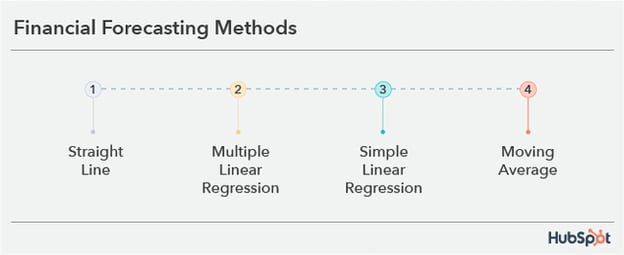
1. Straight Line
True to its name, straight line forecasting is probably the most straightforward financial forecasting method businesses can leverage. It's rooted in basic math and tends to provide rougher projections than the other, more sophisticated methods listed here.
With straight line forecasting, a business gathers rough growth estimates — typically pulled from past figures — and applies them to coming months, quarters, or years. It's generally employed when a company assumes it will see steady growth over a given period.
For instance, if your business has seen revenue reliably grow 5% year over year for the past four years, you might use that figure to guide your straight line forecasting and assume that level of growth will continue for the next few years.
2. Simple Linear Regression
The simple linear regression is a common financial forecasting method where a business explores the relationship between two variables — one independent and one dependent. For instance, a company could use this method to forecast revenue by gauging how it might be impacted by shifts in GDP.
3. Multiple Linear Regression
Simple linear regression analysis often isn't enough to make accurate financial projections, as financial performance is rarely a function of a single factor. The nature of the multiple linear regression is covered by its name — instead of trying to predict how financial performance will play out in response to a single variable, the model considers two or more independent factors.
4. Moving Average
Moving average forecasting is a method most commonly used to identify the trend-direction of a stock, but businesses can still leverage it to project their financial performance. It involves taking the arithmetic mean of a dataset from a past period and applying that average to future projections. The method is typically used to evaluate potential performance over shorter periods — like weeks, months, or quarters.
How to do Financial Forecasting

1. Define your purpose for using a financial forecast.
To get the most out of a financial forecast, you have to know why you're using it in the first place. Ask yourself questions such as:
- What are you hoping to learn and take away from its results?
- Are you trying to get a better gauge of the company budget?
- Are you trying to reach a certain goal or threshold for product sales?
When you have clear intent behind your financial forecast, you'll have a more concise and clear result to search for once you begin.
2. Gather historical data.
To track the progress of your financial forecast, you have to have a good idea of your current and past finances. Take the time to analyze your historical financial data and records, including:
- Revenue and losses
- Equity and liabilities
- Fixed costs
- Investments
- Earnings per share
Your forecast will only be as accurate as the information you collect, so get as much relevant data as possible for better results and understanding.
3. Set a time frame for your forecast.
Decide how far into the future you're committed to recording and documenting your business' financial performance. This can look like weeks, months, quarters, or even years of data collection.
It's most common for a business to conduct a forecast over the course of a fiscal year, but it's unique for every business. And if you need to adjust your forecast as time goes by, or if your goals change, you're ultimately in control and can make adjustments if need be.
4. Choose a forecasting method.
We've already give you four financial forecasting methods, so when choosing the one for your business, make sure it aligns with your previously declared purpose and goals.
5. Monitor and analyze your forecast results.
As your financial forecast delivers new data, you should monitor and analyze it differently. When you get enough data, try to think about how you can use it:
- Identify potential issues: Monitoring and analyzing financial results can help a business identify potential issues before they become more significant problems. For example, if expenses are higher than anticipated, a business can identify the cause and take corrective action to prevent it from negatively impacting financial performance.
- Measure progress towards goals: A financial forecast provides a business with financial goals and expectations. Weighing financial results against these goals enables a business to measure its progress toward achieving them. This can help the business identify where it is falling short and adjust to get back on track.
- Manage cash flow: Monitoring and analyzing financial results can give a business insights into its cash flow situation. By understanding how much cash is coming in and going out, a business can make smarter decisions about budgeting and spending.
And it doesn't have to be a tedious task to analyze your financial data, thankfully there's plenty of forecasting, decision-making and financial-planning tools available for this purpose. Let's go through some of our favorites.
Financial Forecasting Software
1. sage intacct, pricing: contact for pricing.
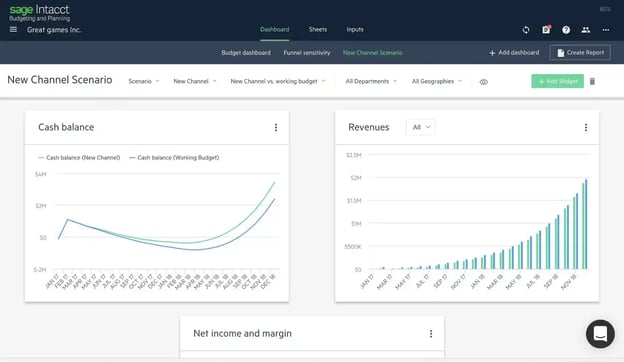
Sage Intacct is a multifaceted accounting and financial planning software with an accessible interface and a suite of features that can streamline your financial forecasting time by over 50%. The platform's automated forecasting resources effectively eliminate the stress, legwork, and room for error that often come with financial planning via spreadsheets.
Best for Collaboration
Sage Intacct separates itself from similar applications through its accessibility and room for collaboration. The software is particularly user-friendly and offers a singular, centralized solution for virtually any stakeholder within an organization to easily contribute to and make sense of financial projections.
2. PlanGuru
Pricing: plans starting at $99 per month.
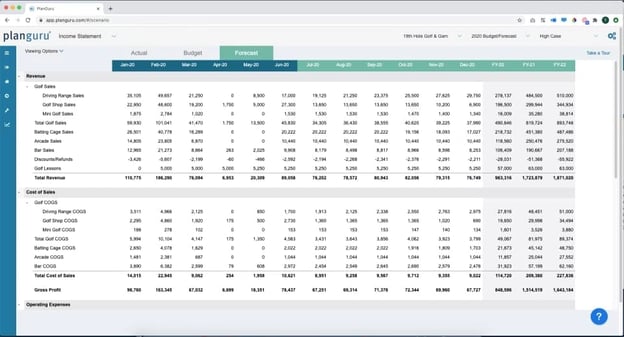
PlanGuru is a dedicated financial forecasting software — supporting 20 separate forecasting methods that can cover projections of up to 10 years. The program also allows you to incorporate non-financial data into your forecasts and has scenario analysis features to help you interpret the ramifications of potentially impactful events. PlanGuru also offers a range of plans to suit most SMBs' budgets.
Best for Pure Financial Forecasting
Some of the other resources listed here are multifaceted accounting solutions that happen to cover financial forecasting — not PlanGuru. This application is primarily dedicated to creating financial projections.
As I mentioned, it offers 20 unique financial forecasting methods to support more effective strategic planning — along with a host of other features tailored to help you gauge your future financial performance. If you're interested in a cost-effective, forecasting-specific platform, look into PlanGuru.
3. Workday Adaptive Planning
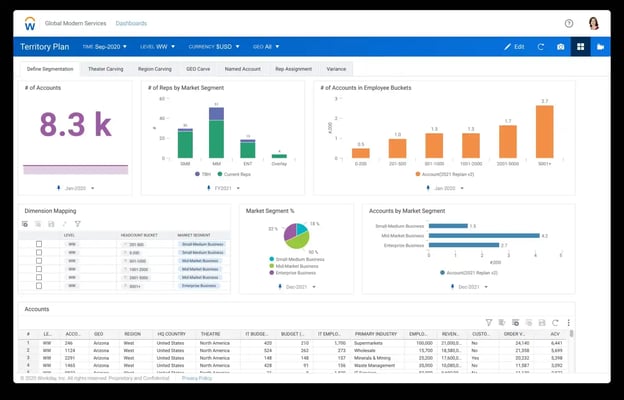
Workday Adaptive Planning provides financial forecasting resources that reconcile accessibility with powerful functionality. The software lets you leverage both real-time financial and operational data to create and compare multiple accurate, effective what-if scenario models. It also allows you to forecast across any time horizon — whether it be daily, monthly, quarterly, or long-term.
Best for a Dynamic Range of Forecasting Options
Workday Adaptive Planning's ability to support detailed bottom-up and top-down forecasts makes it a particularly attractive option for businesses of virtually any size. It allows you to create compelling forecasts based on targets from executive guidance or ground-level operational plans.
That dynamic range of forecasting options helps set the program apart from similar options. If you're interested in software that lets you forecast from various perspectives without sacrificing accuracy or effectiveness, look into Workday Adaptive Planning.
4. Limelight
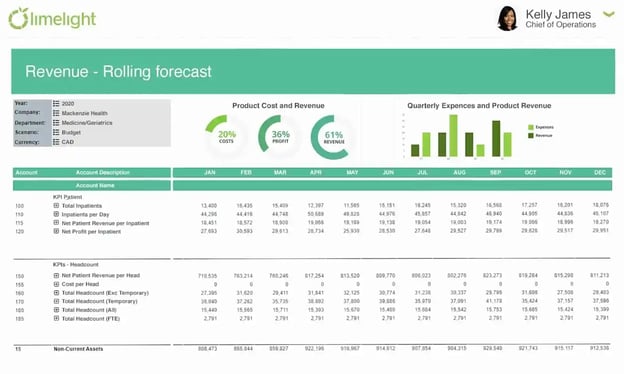
Limelight is an integrated, web-based financial planning that provides businesses with a centralized solution for almost all of their forecasting needs. Designed primarily to suit finance and accounting teams, the software offers powerful general automation and automated data integration to streamline and simplify forecasting without losing out on quality.
Best for a Familiar, Excel-Esque UX
Limelight's user experience is designed to reflect Excel — making it a familiar, particularly easy option for CFOs, controllers, budget managers, and other users to adapt to. If you're interested in a powerful forecasting resource with that kind of accessibility, Limelight might be your best option.
It's never too late to run a financial forecast.
Forecasting is a central component of sound, productive financial planning. If you have no idea what to expect financially, you'll have a hard time preparing for obstacles, setting attainable goals, and identifying aspects of your business that should be of particular interest. No matter the scale or nature of your organization, having a pulse on your financial future is always in your best interest.
Editor's note: This article was originally published in June 2022 and has been updated for comprehensiveness.

Don't forget to share this post!
Related articles.

Entrepreneurial Competency: What it Is & Why it Matters

3 Ways to Cash In on Golf's Takeover by Millennials and Gen Z

This YouTuber Makes $300k A Year Teaching People How to Sew

The $6.8B Sewing Boom Is Here to Stay — 3 Ways to Take Your Cut

Vagus Nerve Care: A $483 Million Health Trend You Need to Know About

A $40m Startup's Founder Shares Insights on Growth and Raising Capital

3 Ways to Build for The Rise (And Fall) of Businesses

8+ Opportunities to Capitalize on The Legal Tech Boom

Top Industries for Entrepreneurs in 2024 According to Our Trends Team

3 Lucrative Ways to Help Seniors Live That Fit and Fabulous Lifestyle
2 Essential Templates For Starting Your Business
Powerful and easy-to-use sales software that drives productivity, enables customer connection, and supports growing sales orgs

How to Create a Financial Forecast
Bryce Warnes
Reviewed by
July 15, 2022
This article is Tax Professional approved
Maybe your goal is world domination. Maybe you just want a sustainable side hustle. Either way, financial forecasting helps you understand the steps you need to take—and the numbers you need to hit—to make growth happen for your business.
I am the text that will be copied.
Plus, if you ever go looking for more funding, you’ll need financial forecasts to prove that your business is on track for growth.
Here’s everything you need on hand, and the steps you can take, to produce a reliable financial forecast.
What is a financial forecast?
A financial forecast tries to predict what your business will look like (financially) in the future. Pro forma financial statements are how you make those predictions somewhat concrete.
Pro forma statements are just like the financial statements you use each month to see how your business is performing. The only difference is that you prepare pro forma statements in advance, for future months and years.
There are three key pro forma statements you should be familiar with:
- The Income Statement
- The Cash Flow Statement
- The Balance Sheet
Helpful resource: How to Read and Analyze Financial Statements
Depending on your goals, these statements will cover different time spans. If you’re creating a financial forecast for your planning purposes, you should create pro forma statements covering six months to one year in the future.
If you’re presenting your forecast to a lender or investor, though, you should create pro forma statements covering the next one to three years.
Financial forecasting vs. budgeting
When you create a budget for your business , you plan to set aside money for certain costs, taking into account your income and expenses. The budget you make may be based on info from your financial forecast, but it’s distinct from the forecast itself.
Think of financial forecasting as a prediction, and budgeting as a plan. When you make a financial forecast, you see what direction your business is headed in, based on past performance and other factors, and use that to anticipate the future.
When you make a budget, you plan how you’re going to spend money based on what you expect your finances to look like in the future (your forecast).
For instance, if your financial forecast for next year says you’ll have an extra $5,000 in revenue, you might create a budget to decide how it will be spent—$2,000 for a new website, $1,000 for Facebook ads, and so on.

Three steps to creating your financial forecast
Ready to peer into the crystal ball and see the future of your business? There are three steps you need to follow:
- Gather your past financial statements. You’ll need to look at your past finances in order to project your income, cash flow, and balance.
- Decide how you’ll make projections. Besides past records, there’s other data you can draw on to make your projections more accurate.
- Prepare your pro forma statements. Pour a coffee and get ready to crunch some numbers.
Step one: Gather your records
If you’re not looking into the past to see how your business has grown, you’re not really forecasting—you’re just guessing.
You’ll need to gather past financial statements so you can see how your business has developed over time, and then project that development into the future.
Your bookkeeper or bookkeeping software should generate financial statements for you. If you don’t have either, and you don’t have financial statements, you’ll need to take care of that before you can start forecasting. You need complete bookkeeping in order to get the transaction history you base your financial statements on.
Put aside the task for financial forecasting for the moment, and learn how to catch up on your bookkeeping .
Once your books and financial statements are up to date, you’ll have everything you need to start planning for the future.
Step two: Decide how you’ll make your forecast
Depending what resources you choose to use, the type of forecast you create will fall between two poles— historical and researched-based.
Almost every financial forecast includes a little bit of historical forecasting, and a little bit that’s research-based. The blend you choose will depend on your needs and the resources at your disposal.
Remember, the goal is to create a realistic, useful forecast—without breaking the bank or eating up all your time.
Historical forecasting
When you use your financial history to plot the future, it’s historical forecasting . You’re looking at your last few annual Income Statements, Cash Flow Statements, and Balance Sheets to see how fast you’ve grown in the past. From there, you can make a guess about how fast you’ll grow this year.
The benefit of this is that it’s relatively easy to do and doesn’t take a lot of time, money, or expertise. The drawback is that you’re only using info about your own business, and not looking at broader market trends—like what your competition has been up to.
Historical forecasting is a good bet if you’re forecasting for modest growth, or else creating a quick-and-dirty forecast for your own use—not putting together a presentation for potential investors.
Research-based forecasting
When you do research about broader market trends, you’re using research-based forecasting . You may look at how your industry has performed over the past ten years, investigate new technologies and consumer trends, or try to measure the progress of your competitors. You might look at how companies similar to yours have planned their own growth.
The benefit of research-based forecasting is that you get a detailed, nuanced view of how your business could grow, taking into account a lot of different factors. And it’s the kind of forecast that investors and lenders want to see.
The drawback is that researched-based forecasting can be expensive. You may find you need to hire outside consultants and researchers to handle the heavy lifting.
Research-based forecasting is a good choice if you’re courting investors, or planning on rapid, aggressive growth. It’s also good if your company is brand new, and doesn’t have a lot of financial history to draw on for making projections
Step three: Create pro forma statements
Once you’ve collected the information you need to build your forecast, you can create pro forma statements.
We’ll cover the three key financial statements here. Whether you use all of them is up to you.
If you’re creating a quick forecast for your own planning, you may only need to create pro forma Income Statements. If you’re presenting to lenders or investors, you’ll want to use all three.
Rule of thumb: Any form you’d use in the month-to-month operation of your business should be created pro forma. For instance, if you move a lot of cash around every month, and you rely on Cash Flow Statements to make sure you’ve got enough money on hand to pay your vendors, then it’s wise to create pro forma Cash Flow Statements as part of your forecast.
Creating the pro forma Income Statement
First, set a goal—a projection—for sales in the period you’re looking at.
Let’s say you made $30,000 in sales this year. Next year, you want to make $60,000. So, your total sales will increase by $30,000.
Set a production schedule that will let you reach that goal, and map it out over the time period you’re covering. In our example, there will be 12 Income Statements in the year to come (one each month). Map out that $30,000 increase in sales over the 12 statements.
You could do this by increasing sales a fixed amount every month, or gradually increasing the amount of sales you make per month. It’s up to your instincts and experience as a business owner.
Then, it’s time for the “loss” part of “ profit and loss .” Calculate the cost of goods sold for each month, and deduct it from your sales. Deduct any other operating expenses you have, as well.
It’s important to take every expense into account so you get an accurate projection. If part of your plan is quadrupling your online advertising, be sure to include an expense that reflects that.
Once you’re done, your pro Forma Income Statements show you how much you can expect to earn and how much you can expect to spend in the time ahead.
Example Pro Forma Income Statement:
Karen’s Falafel Warehouse
Creating the pro forma Cash Flow Statement
You create a pro forma Cash Flow Statement a lot like the way you’d create a regular Cash Flow Statement. That means taking info from the Income Statement, and using the Cash Flow Statement format to plot out where your money is going, and how much you’ll have on hand at any one time.
Your projected cash flow can tell you a few things. If it’s in the negative, it means you’re not going to have enough cash on-hand to run your business, according to your current trajectory. You’ll need to make plans to borrow money and pay it off.
If your net cash flow is positive, you can plan on having enough surplus cash on hand to pay off loans, or save for a big investment.
Example Pro Forma Cash Flow Statement:
Ruth’s Raccoon Rescue and Rehabilitation Center
Creating the pro forma Balance Sheet
Drawing on info from the Income Statement and the Cash Flow Statement lets you create pro forma Balance Sheets. But you’ll also need previous Balance Sheets to make this useful—so you can follow the story of how your business got from “Balance A” to “Balance B.”
The Balance Sheet will project changes in your business accounts over time. That way, you can plan where to move money, when.
Example Pro Forma Balance Sheet:
Big Bill’s Budget Wedding Videos
Forecast vs. actuals
Once you’ve created a financial forecast, your work isn’t done. The vital second stage is to go back and record what your actual financials were in comparison to your forecast once the month or year is over.
Why is this so vital?
It helps you learn to forecast better next year, and when your forecast is way off, you can take notes for yourself on why that was.
For example:
- March revenue was much higher than I forecasted for. I didn’t realize there would be a seasonal boost over spring break.
- Sales were lower than I forecasted in the June. There was a miscommunication with the supplier and I didn’t have all the inventory I needed.
These mundane notes to yourself accumulate into invaluable business knowledge that help make every year more successful than the last.
Best, worst, and normal case projections
Whether you’re the kind of person who always sees the glass half full, or the kind who always sees it half empty, it’s a good idea to take into account different possible outcomes for your business.
Humans aren’t very good at predicting the future. Consider creating three different forecasts: One for the best case scenario, one for the worst, and one for the middle or “regular” scenario.
- Maybe the t-shirts you buy wholesale for your online store go up in price, like they did last year. Factor that into your worst case scenario .
- Maybe t-shirt prices stay the same, plus your new advertising plan takes off, and you get more business. Consider that the best case.
- Maybe everything more or less stays the same. Let’s call that the regular case.
The best/worst/regular trifecta is also useful when you’re making a budget for your business. For example, in January you might budget for a regular scenario. In this case, that means monthly sales revenue of $8,000.
However, in February say your revenue hits $10,000, and in March it’s $11,000. At that point, you may want to adjust your budget to the best case to scenario—since you’ll now have more money to reinvest in your business.
At the end of the day, the more robust your forecast, the better you’ll be able to plan the future of your business, and think on your feet. Plus, you’ll impress investors and lenders, by proving you’ve considered (almost) every possible outcome.
The better you understand how financial statements work, the easier you’ll find it to create financial forecasts. Before you start forecasting, take a look at our other helpful resources for understanding your small business financials:
- Financial Literacy 101 for Small Business Owners
- 10 Financial Ratios Every Small Business Owner Should Know
- Accounting Solutions: The Top 7 Ways to Get Your Accounting Done
Related Posts
.png)
How to Calculate Gross Income for the PPP
On February 22, the PPP changed so the self-employed can apply using gross income. But what does that mean for your PPP loan amount? Here's our guide on how to calculate gross income for the PPP.

The Top Trucking Accounting Software
Find the best trucking accounting software for your business with our comparison guide. Read about features, pricing, and more to make the best decision for your company.

A Relatively Painless Guide to Double-Entry Accounting
A (relatively) painless rundown of the double-entry system of accounting, and why your business should probably switch to it immediately.
Join over 140,000 fellow entrepreneurs who receive expert advice for their small business finances
Get a regular dose of educational guides and resources curated from the experts at Bench to help you confidently make the right decisions to grow your business. No spam. Unsubscribe at any time.

Financial forecast example for new businesses and startups
The financial forecast is an essential step when creating a business plan. The financial forecast allows you to anticipate the revenues and expenses of your new business over a given period.
Even if the exercise is sometimes delicate to carry out, it is nevertheless essential for any entrepreneur. Indeed, it allows you to define quantified objectives, which, if meticulously tracked, will allow you to grow your business in good conditions.
To help you, here's a financial forecast example as well as tools you can use to create yours.

Financial forecast examples for new businesses
Example of a sales forecast.
The sales forecast is used to estimate the company's turnover. It is generally presented by category of products and services, types of customers, or time slots.
In our financial forecast example, we have included below a sales forecast for a hostel, organised by categories of services with the bed's occupancy forecast broken down based on seasonality:
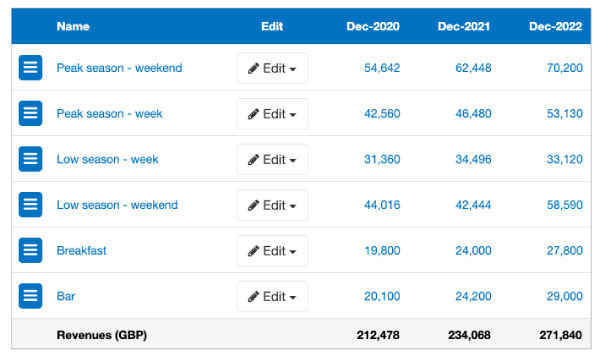
To ensure a fair and realistic evaluation of your company's revenues, You will need to base your forecast on thorough and reliable market analysis, including an analysis of what your competition offers. You will also need to think carefully about your pricing policy and distribution strategy beforehand.
Examples of financial statements to include in your forecast
Your forecast will need to include 3 financial statements:
- The P&L statement
- The cash flow statement
- The balance sheet
P&L statement
The profit and loss statement enables you to assess:
- the growth of the company by analyzing the evolution of the turnover over several years;
- the profitability of the company by looking at the difference between the expected revenues and the costs which will need to be incurred to generate these sales.
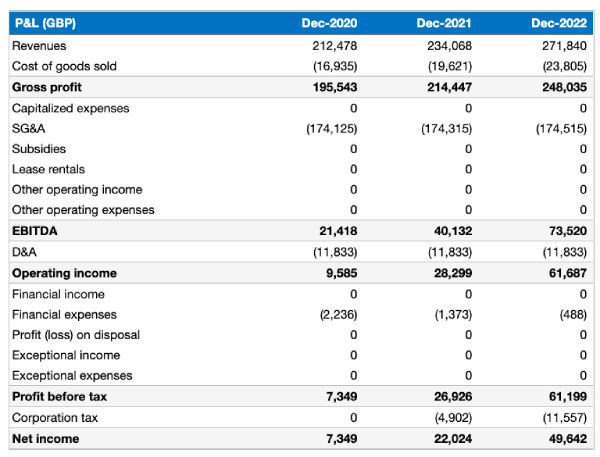
The main shortcoming of the projected income statement is that it does not take into account cash flows. Your profits should turn into cash at some point, but based on when your clients pay you, how much inventory you keep, or when you pay your suppliers, the cash flow could be very different from your profit.
To overcome this shortcoming, we need to look at the forecasted cash flow statement included in our financial forecast example.
Cash flow statement
The cash flow statement shows all anticipated cash movements for a given year.
It enables you to evaluate:
- the ability to generate operating cash flow;
- the company's investment and financing policies.
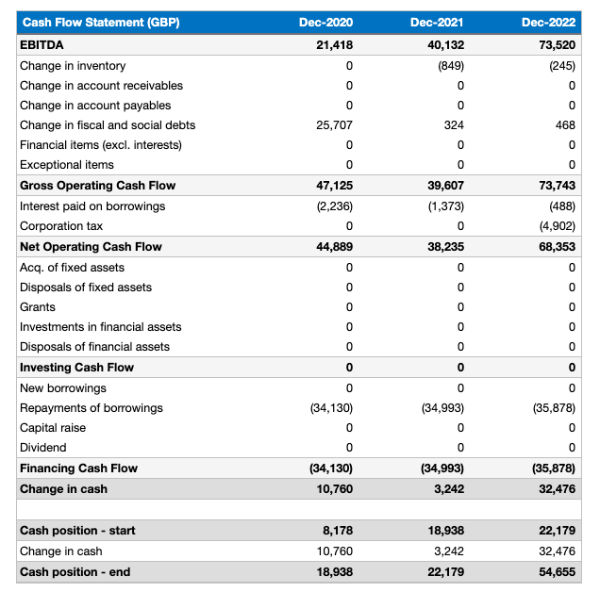
The cash flow statement is highly complementary to the P&L statement. Together they provide a clear view of the company's profitability, the cash generated by the operations, the investments made and the financing flows.
Balance sheet
The forecasted balance sheet, the last link in the chain, provides an overview of the company's net worth at a given moment in time and is part of our financial forecast example. It enables you to evaluate:
- the value of the company's assets;
- the weight of its working capital;
- the level of financial indebtedness;
- the book value of shareholders' equity.
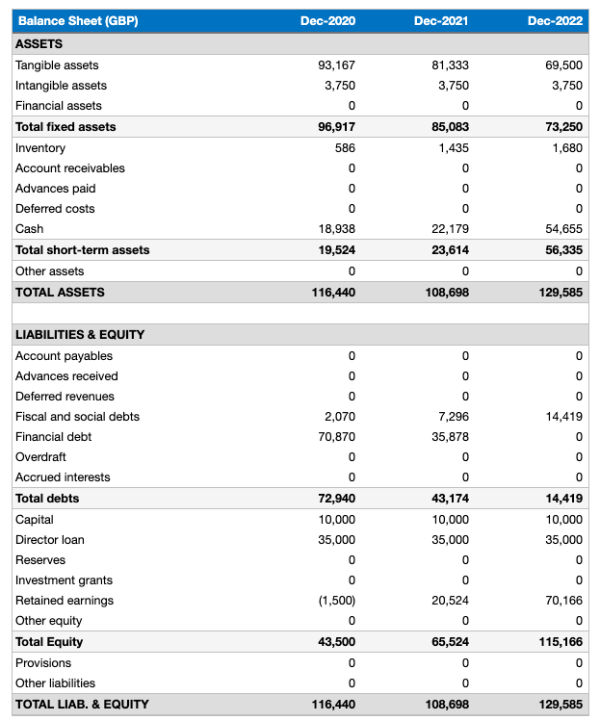
The forecasted balance sheet complements the other two tables. Nevertheless, it has two weak points:
- It provides a snapshot of the company's net worth at a specific moment in time - giving a very static view of the company. Especially given the balance sheet is usually produced several months after the end of the financial year (and therefore the information it contains is already stale!)
- It gives an accounting vision of the company, based on historical cost, and not a financial vision, based on market value.
Where can I find other financial forecast examples?
At The Business Plan Shop, we offer an online software that includes a financial forecasting tool and helps you throughout the drafting of the business plan on top of financial forecast examples included in our business plan templates .
Using a software like ours to realize your business plan has several advantages:
- You can easily create your financial forecast by letting the software take care of the calculations and financial aspects for you.
- You are guided in the drafting process by detailed instructions and examples for each part of the plan.
- You get a professional document, formatted and ready to be sent to your bank or investors.
If you are interested in our solution, you can try our software for free here .
Our article is coming to an end. We hope that our financial forecast example has given you a better understanding of what this exercise is all about.
The forecast is a crucial element of a business plan that will be of particular interest to your financial partners if you are looking for financing; but don't forget that it is also a mean for you, as an entrepreneur, to evaluate the viability of your new business idea.
Also on The Business Plan Shop
- How to do financial projections for a new business?
- How to establish a Profit & Loss forecast in your business plan?
- How to do a financial forecast for a restaurant?

Founder & CEO at The Business Plan Shop Ltd
Guillaume Le Brouster is a seasoned entrepreneur and financier.
Guillaume has been an entrepreneur for more than a decade and has first-hand experience of starting, running, and growing a successful business.
Prior to being a business owner, Guillaume worked in investment banking and private equity, where he spent most of his time creating complex financial forecasts, writing business plans, and analysing financial statements to make financing and investment decisions.
Guillaume holds a Master's Degree in Finance from ESCP Business School and a Bachelor of Science in Business & Management from Paris Dauphine University.
Create a convincing business plan
Assess the profitability of your business idea and create a persuasive business plan to pitch to investors

500,000+ entrepreneurs have already tried our solution - why not join them?
Not ready to try our on-line tool ? Learn more about our solution here
Need some inspiration for your business plan?
Subscribe to The Business Plan Shop and gain access to our business plan template library.

Need a professional business plan? Discover our solution
Write your business plan with ease!

It's easy to create a professional business plan with The Business Plan Shop
Want to find out more before you try? Learn more about our solution here
- Search Search Please fill out this field.
- Building Your Business
- Becoming an Owner
- Business Plans
Writing a Business Plan—Financial Projections
Spell out your financial forecast in dollars and sense
Creating financial projections for your startup is both an art and a science. Although investors want to see cold, hard numbers, it can be difficult to predict your financial performance three years down the road, especially if you are still raising seed money. Regardless, short- and medium-term financial projections are a required part of your business plan if you want serious attention from investors.
The financial section of your business plan should include a sales forecast , expenses budget , cash flow statement , balance sheet , and a profit and loss statement . Be sure to follow the generally accepted accounting principles (GAAP) set forth by the Financial Accounting Standards Board , a private-sector organization responsible for setting financial accounting and reporting standards in the U.S. If financial reporting is new territory for you, have an accountant review your projections.
Sales Forecast
As a startup business, you do not have past results to review, which can make forecasting sales difficult. It can be done, though, if you have a good understanding of the market you are entering and industry trends as a whole. In fact, sales forecasts based on a solid understanding of industry and market trends will show potential investors that you've done your homework and your forecast is more than just guesswork.
In practical terms, your forecast should be broken down by monthly sales with entries showing which units are being sold, their price points, and how many you expect to sell. When getting into the second year of your business plan and beyond, it's acceptable to reduce the forecast to quarterly sales. In fact, that's the case for most items in your business plan.
Expenses Budget
What you're selling has to cost something, and this budget is where you need to show your expenses. These include the cost to your business of the units being sold in addition to overhead. It's a good idea to break down your expenses by fixed costs and variable costs. For example, certain expenses will be the same or close to the same every month, including rent, insurance, and others. Some costs likely will vary month by month such as advertising or seasonal sales help.
Cash Flow Statement
As with your sales forecast, cash flow statements for a startup require doing some homework since you do not have historical data to use as a reference. This statement, in short, breaks down how much cash is coming into your business on a monthly basis vs. how much is going out. By using your sales forecasts and your expenses budget, you can estimate your cash flow intelligently.
Keep in mind that revenue often will trail sales, depending on the type of business you are operating. For example, if you have contracts with clients, they may not be paying for items they purchase until the month following delivery. Some clients may carry balances 60 or 90 days beyond delivery. You need to account for this lag when calculating exactly when you expect to see your revenue.
Profit and Loss Statement
Your P&L statement should take the information from your sales projections, expenses budget, and cash flow statement to project how much you expect in profits or losses through the three years included in your business plan. You should have a figure for each individual year as well as a figure for the full three-year period.
Balance Sheet
You provide a breakdown of all of your assets and liabilities in the balances sheet. Many of these assets and liabilities are items that go beyond monthly sales and expenses. For example, any property, equipment, or unsold inventory you own is an asset with a value that can be assigned to it. The same goes for outstanding invoices owed to you that have not been paid. Even though you don't have the cash in hand, you can count those invoices as assets. The amount you owe on a business loan or the amount you owe others on invoices you've not paid would count as liabilities. The balance is the difference between the value of everything you own vs. the value of everything you owe.
Break-Even Projection
If you've done a good job projecting your sales and expenses and inputting the numbers into a spreadsheet, you should be able to identify a date when your business breaks even—in other words, the date when you become profitable, with more money coming in than going out. As a startup business, this is not expected to happen overnight, but potential investors want to see that you have a date in mind and that you can support that projection with the numbers you've supplied in the financial section of your business plan.
Additional Tips
When putting together your financial projections, keep some general tips in mind:
- Get comfortable with spreadsheet software if you aren't already. It is the starting point for all financial projections and offers flexibility, allowing you to quickly change assumptions or weigh alternative scenarios. Microsoft Excel is the most common, and chances are you already have it on your computer. You can also buy special software packages to help with financial projections.
- Prepare a five-year projection . Don’t include this one in the business plan, since the further into the future you project, the harder it is to predict. However, have the projection available in case an investor asks for it.
- Offer two scenarios only . Investors will want to see a best-case and worst-case scenario, but don’t inundate your business plan with myriad medium-case scenarios. They likely will just cause confusion.
- Be reasonable and clear . As mentioned before, financial forecasting is as much art as science. You’ll have to assume certain things, such as your revenue growth, how your raw material and administrative costs will grow, and how effective you’ll be at collecting on accounts receivable. It’s best to be realistic in your projections as you try to recruit investors. If your industry is going through a contraction period and you’re projecting revenue growth of 20 percent a month, expect investors to see red flags.
Free Financial Projection and Forecasting Templates
By Andy Marker | January 3, 2024
- Share on Facebook
- Share on LinkedIn
Link copied
We’ve collected the top free financial projection and forecasting templates. These templates enable business owners, CFOs, accountants, and financial analysts to plan future growth, manage cash flow, attract investors, and make informed decisions. On this page, you'll find many helpful, free, customizable financial projection and forecasting templates, including a 1 2-month financial projection template , a startup financial projection template , a 3-year financial projection template , and a small business financial forecast template , among others. You’ll also find details on the elements in a financial projection template , types of financial projection and forecasting templates , and related financial templates .
Simple Financial Projection Template

Download a Sample Simple Financial Projection Template for
Excel | Google Sheets
Download a Blank Simple Financial Projection Template for
Excel | Google Sheets
Small business owners and new entrepreneurs are the ideal users for this simple financial projection template. Just input your expected revenues and expenses. This template stands out due to its ease of use and focus on basic, straightforward financial planning, making it perfect for small-scale or early-stage businesses. Available with or without sample text, this tool offers clear financial oversight, better budget management, and informed decision-making regarding future business growth.
Looking for help with your business plan? Check out these free financial templates for a business plan to streamline the process of organizing your business's financial information and presenting it effectively to stakeholders.
Financial Forecast Template
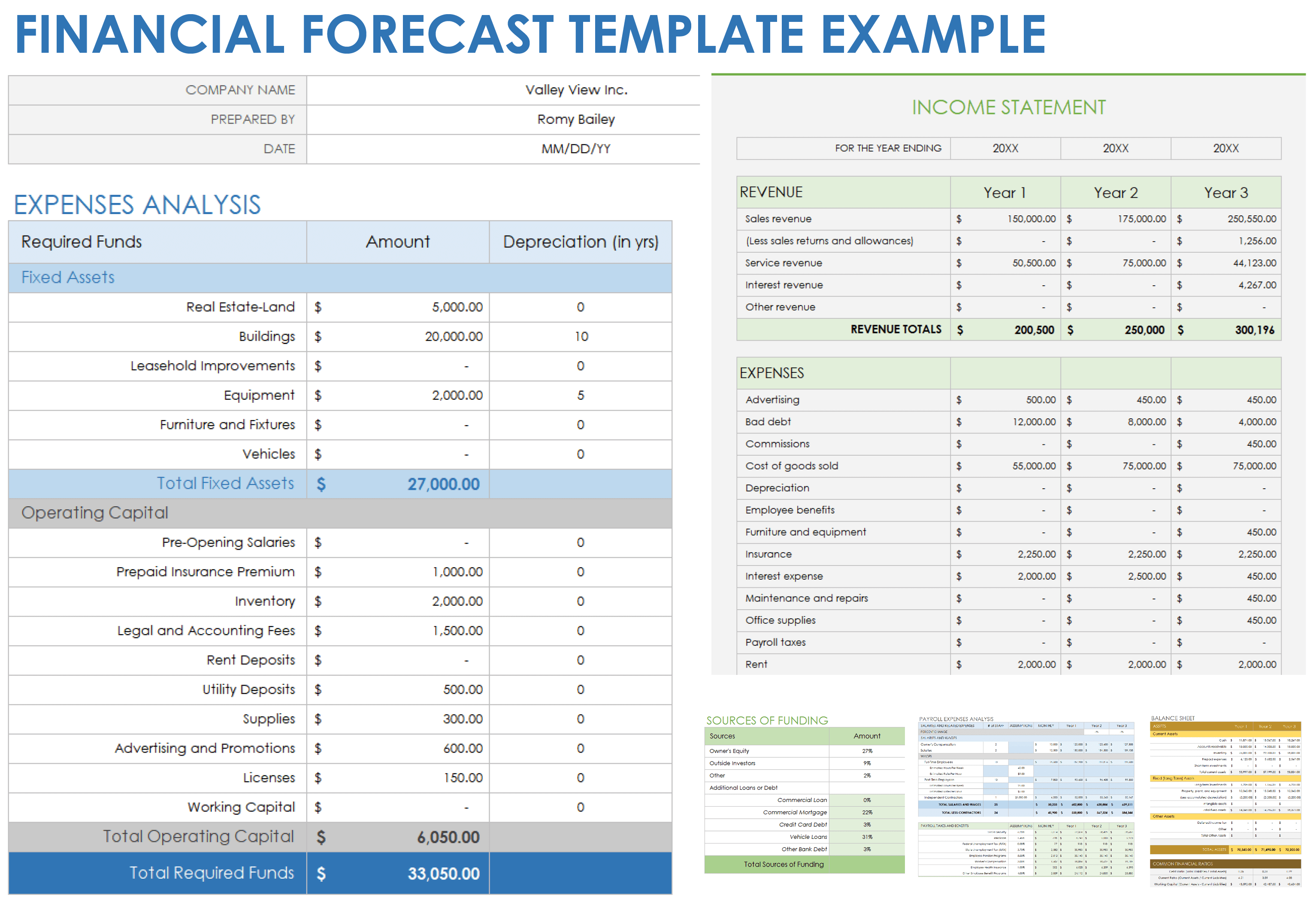
Download a Sample Financial Forecast Template for
Download a Blank Financial Forecast Template for
This template is perfect for businesses that require a detailed and all-encompassing forecast. Users can input various financial data, such as projected revenues, costs, and market trends, to generate a complete financial outlook. Available with or without example text, this template gives you a deeper understanding of your business's financial trajectory, aiding in strategic decision-making and long-term financial stability.
These free cash-flow forecast templates help you predict your business’s future cash inflows and outflows, allowing you to manage liquidity and optimize financial planning.
12-Month Financial Projection Template
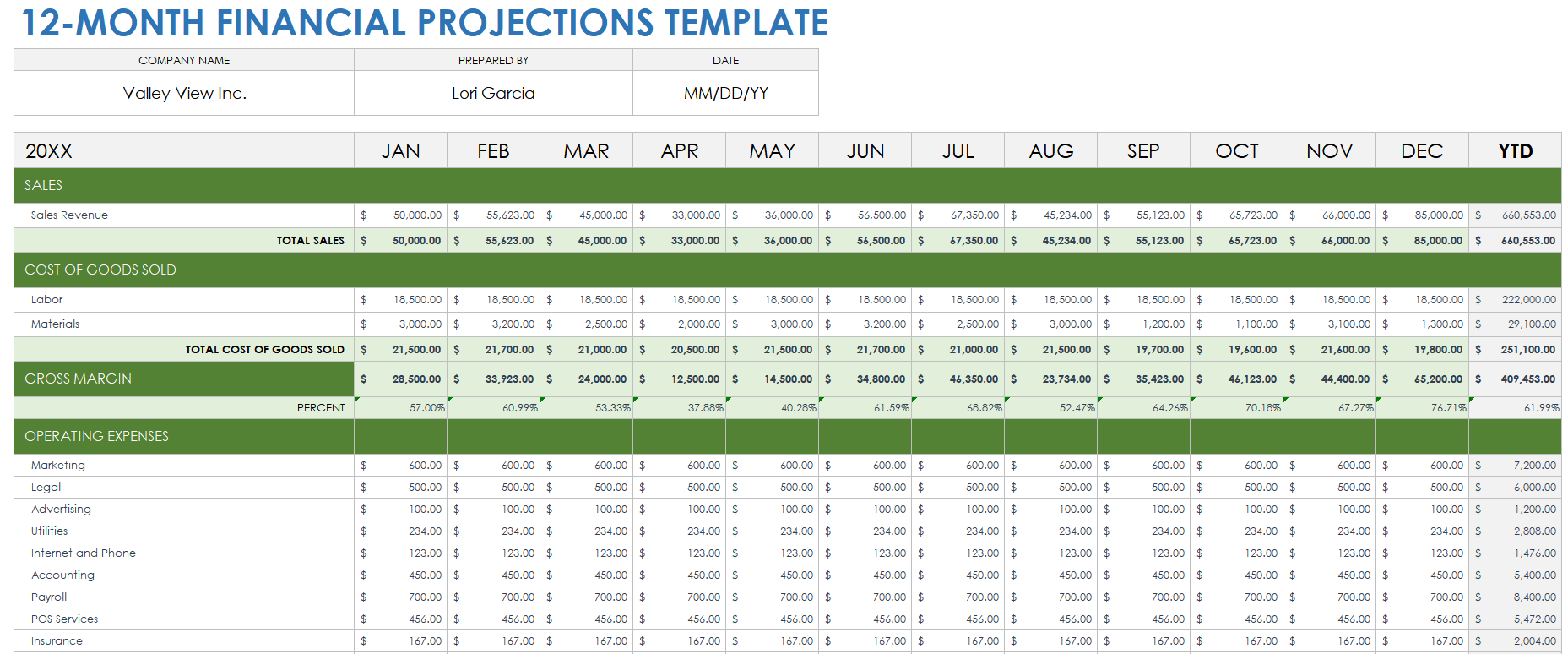
Download a Sample 12-Month Financial Projection Template for
Download a Blank 12-Month Financial Projection Template for
Use this 12-month financial projection template for better cash-flow management, more accurate budgeting, and enhanced readiness for short-term financial challenges and opportunities. Input estimated monthly revenues and expenses, tracking financial performance over the course of a year. Available with or without sample text, this template is ideal for business owners who need to focus on short-term financial planning. This tool allows you to respond quickly to market shifts and plan effectively for the business's crucial first year.
Download free sales forecasting templates to help your business predict future sales, enabling better inventory management, resource planning, and decision-making.
Startup Financial Projection Template
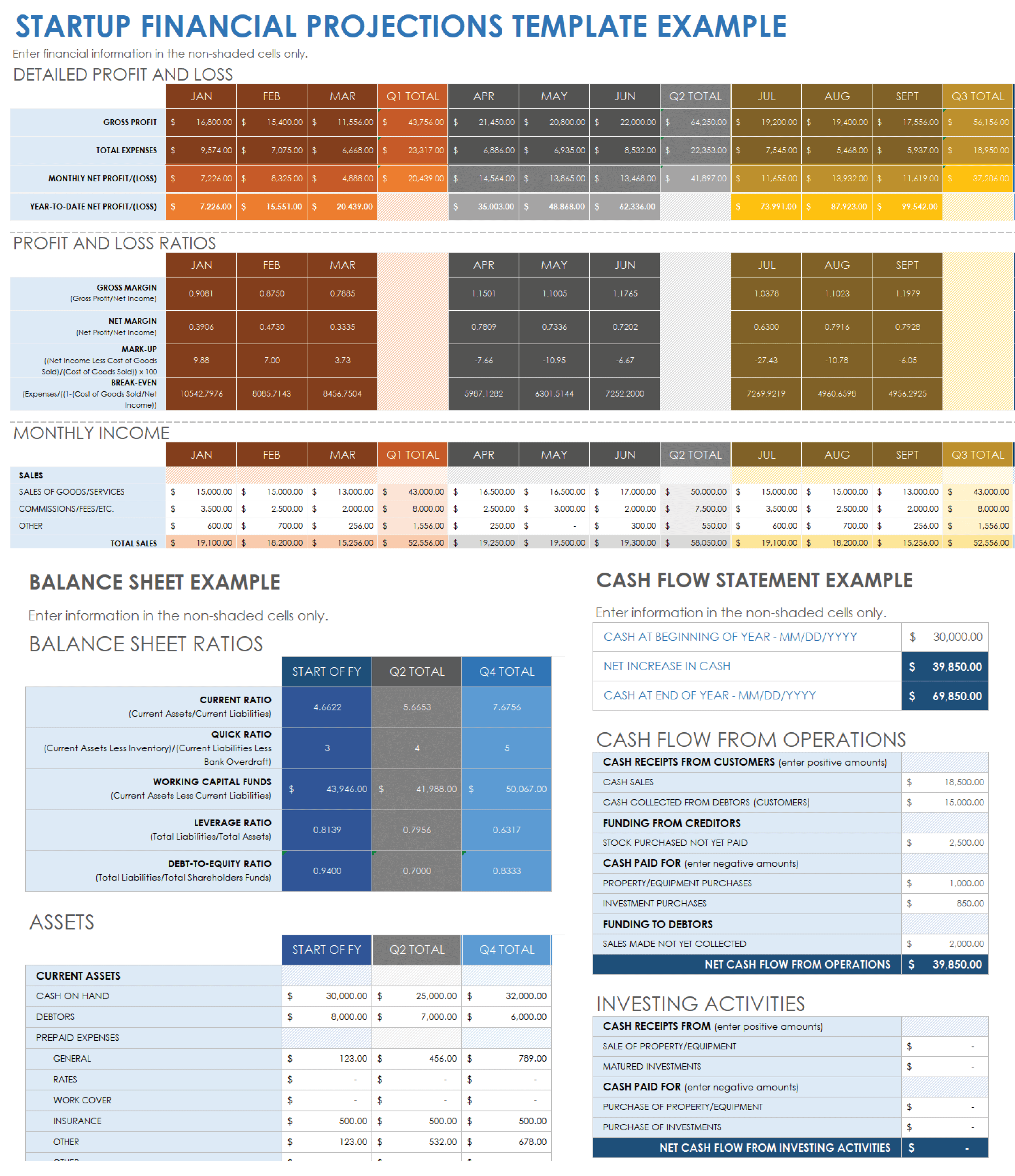
Download a Sample Startup Financial Projection Template for
Download a Blank Startup Financial Projection Template for
This dynamic startup financial projection template is ideal for startup founders and entrepreneurs, as it's designed specifically for the unique needs of startups. Available with or without example text, this template focuses on clearly outlining a startup's initial financial trajectory, an essential component for attracting investors. Users can input projected revenues, startup costs, and funding sources to create a comprehensive financial forecast.
3-Year Financial Projection Template
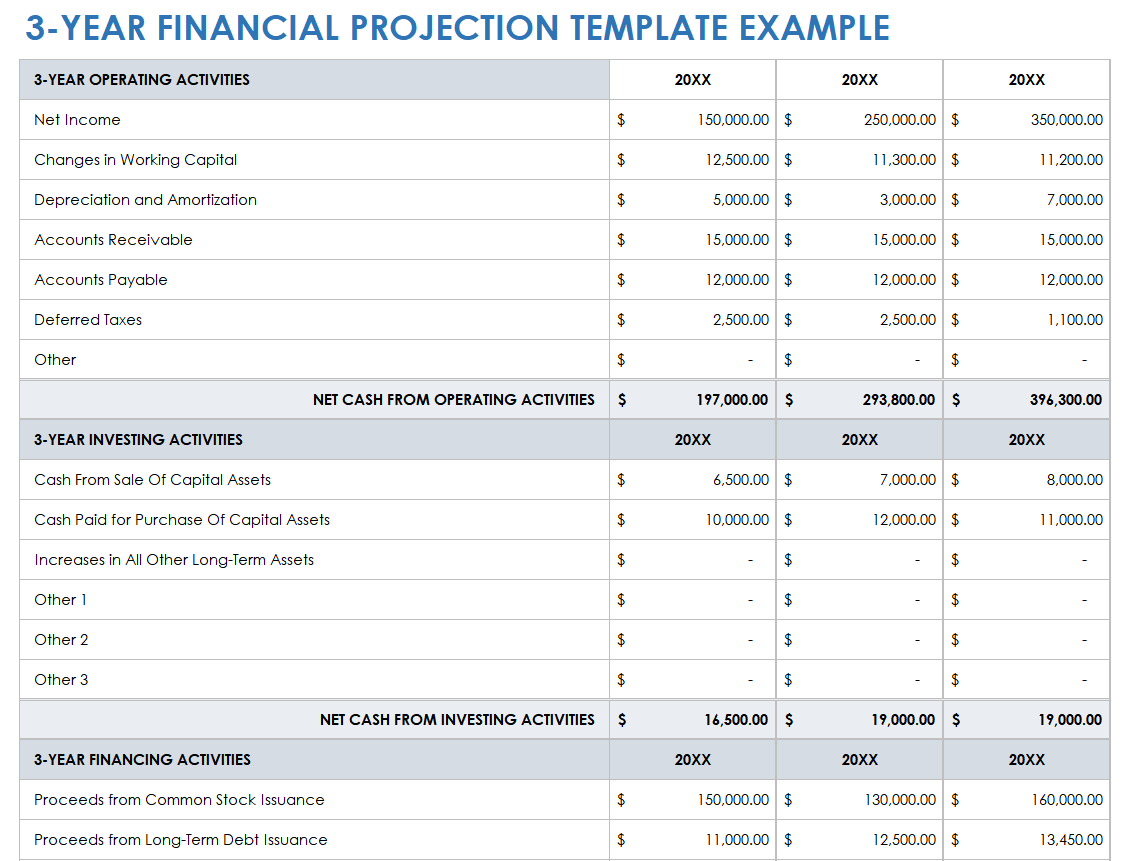
Download a Sample 3-Year Financial Projection Template for
Download a Blank 3-Year Financial Projection Template for
This three-year financial projection template is particularly useful for business strategists and financial planners who are looking for a medium-term financial planning tool. Input data such as projected revenues, expenses, and growth rates for the next three years. Available with or without sample text, this template lets you anticipate financial challenges and opportunities in the medium term, aiding in strategic decision-making and ensuring sustained business growth.
5-Year Financial Forecasting Template
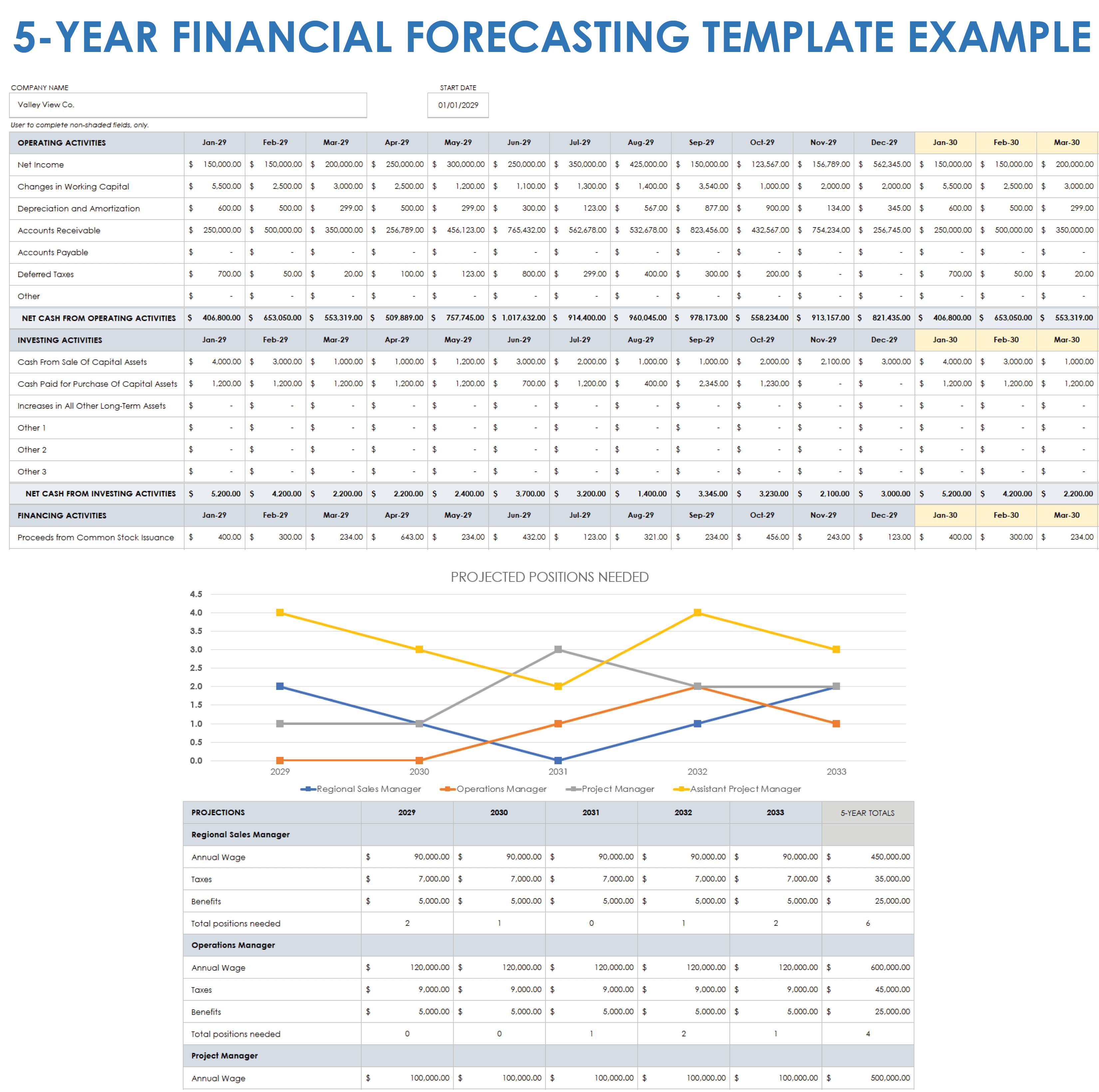
Download a Sample 5-Year Financial Forecasting Template for
Download a Blank 5-Year Financial Forecasting Template for
CFOs and long-term business planners can use this five-year financial forecasting template to get a clear, long-range financial vision. Available with or without example text, this template allows you to plan strategically and invest wisely, preparing your business for future market developments and opportunities. This unique tool offers an extensive outlook for your business’s financial strategy. Simply input detailed financial data spanning five years, including revenue projections, investment plans, and expected market growth. Visually engaging bar charts of key metrics help turn data into engaging narratives.
Small Business Financial Forecast Template
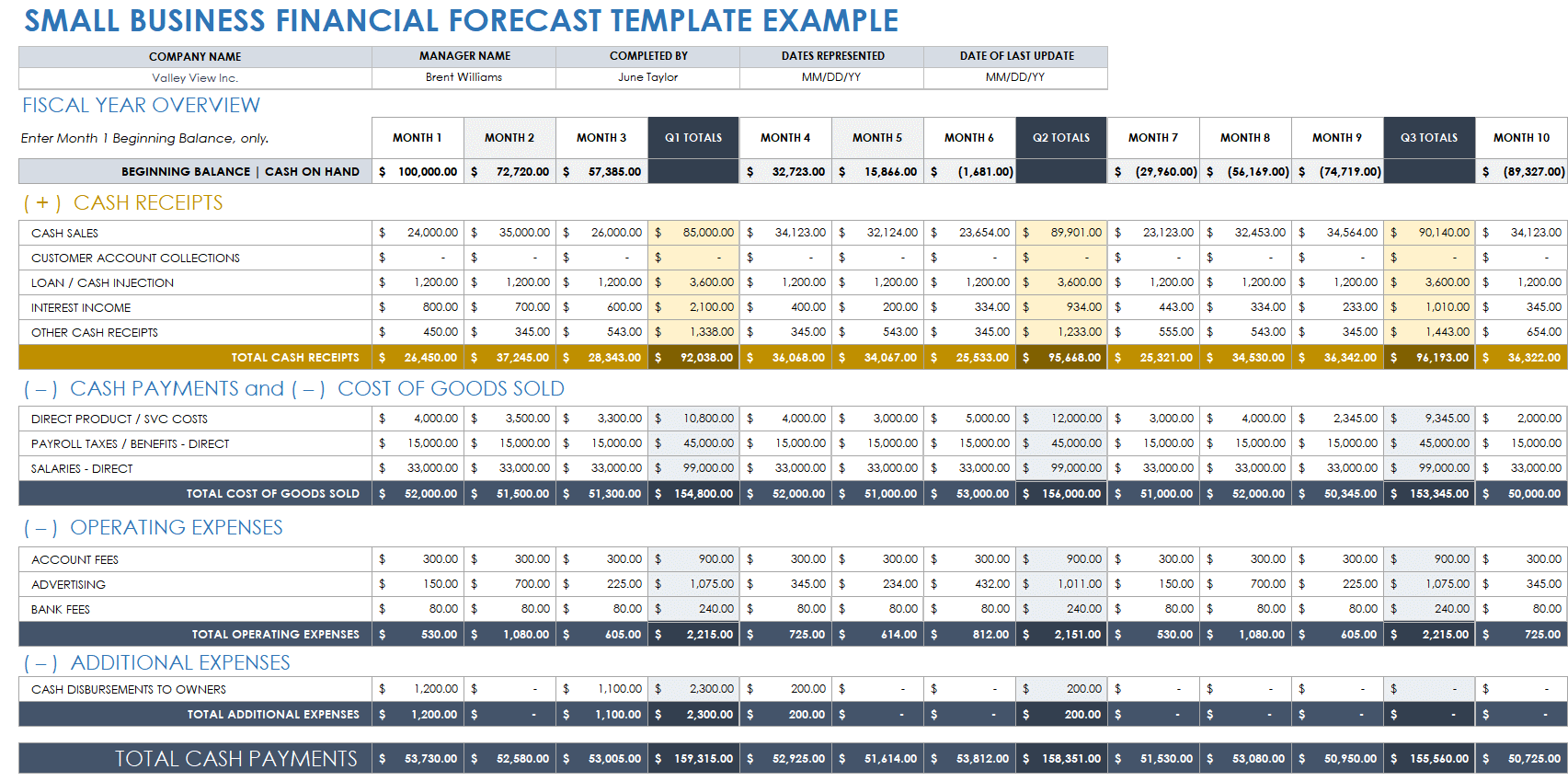
Download a Sample Small Business Financial Forecast Template for
Download a Blank Small Business Financial Forecast Template for
Excel | Google Sheets
The small business financial forecast template is tailored specifically for the scale and specific requirements of small enterprises. Business owners and financial managers can simply input data such as projected sales or expenses. Available with or without sample text, this tool offers the ability to do the following: envision straightforward financial planning; anticipate future financial needs and challenges; make informed decisions; and steer the business toward steady growth.
Elements in a Financial Projection Template
The elements in a financial projection template include future sales, costs, profits, and cash flow. This template illustrates expected receivables, payables, and break-even dates. This tool helps you plan for your business's financial future and growth.
Here are the standard elements in a financial projection template:
- Revenue Projection: This estimates future income from various sources over a specific period.
- Expense Forecast: This predicts future costs, including both fixed and variable expenses.
- Profit and Loss Forecast: This projects the profit or loss by subtracting projected expenses from projected revenues.
- Cash-Flow Projection: This assesses the inflows and outflows of cash, indicating liquidity over time.
- Balance Sheet Projection: This predicts the future financial position, showing assets, liabilities, and equity.
- Break-Even Analysis: This calculates the point at which total revenues equal total costs.
- Capital Expenditure Forecast: This estimates future spending on fixed assets such as equipment or property.
- Debt Repayment Plan: This outlines the schedule for paying back any borrowed funds.
- Sales Forecast: This predicts future sales volume, often broken down by product or service.
- Gross Margin Analysis: This looks at the difference between revenue and cost of goods sold.
Types of Financial Projection and Forecasting Templates
There are many types of financial projection and forecasting templates: basic templates for small businesses; detailed ones for big companies; special ones for startup businesses; and others. There are also sales forecasts, cash-flow estimates, and profit and loss projections.
In addition, financial projection and forecasting templates include long-term planning templates, break-even analyses, budget forecasts, and templates made for specific industries such as retail or manufacturing.
Each template serves different financial planning needs. Determine which one best suits your requirements based on the scale of your business, the complexity of its financial structure, and the specific department that you want to analyze.
Here's a list of the top types of financial projection and forecasting templates:
- Basic Financial Projection Template: Ideal for small businesses or startups, this template provides a straightforward approach to forecasting revenue, expenses, and cash flow.
- Detailed Financial Projection Template: Best for larger businesses or those with complex financial structures, this template offers in-depth projections, including balance sheets, income statements, and cash-flow statements.
- Startup Financial Projection Template: Tailored for startups, this template focuses on funding requirements and early-stage revenue forecasts, both crucial for attracting investors and planning initial operations.
- Sales Forecasting Template: Used by sales and marketing teams to predict future sales, this template helps you set targets and plan marketing strategies.
- Cash-Flow Forecast Template: Essential for financial managers who need to monitor the liquidity of the business, this template projects cash inflows and outflows over a period.
- Profit and Loss Forecast Template (P&L): Useful for business owners and financial officers who need to anticipate profit margins, this template enables you to forecast revenues and expenses.
- Three-Year / Five-Year Financial Projection Template: Suitable for long-term business planning, these templates provide a broader view of your company’s financial future, improving your development strategy and investor presentations.
- Break-Even Analysis Template: Used by business strategists and financial analysts, this template helps you determine when your business will become profitable.
- Budget Forecasting Template: Designed for budget managers, this template uses historical financial data to help you plan your future spending.
- Sector-Specific Financial Projection Template: Designed for specific industries (such as retail or manufacturing), these templates take into account industry-specific factors and benchmarks.
Related Financial Templates
Check out this list of free financial templates related to financial projections and forecasting. You'll find templates for budgeting, tracking profits and losses, planning your finances, and more. These tools help keep your company’s money matters organized and clear.
Free Project Budget Templates
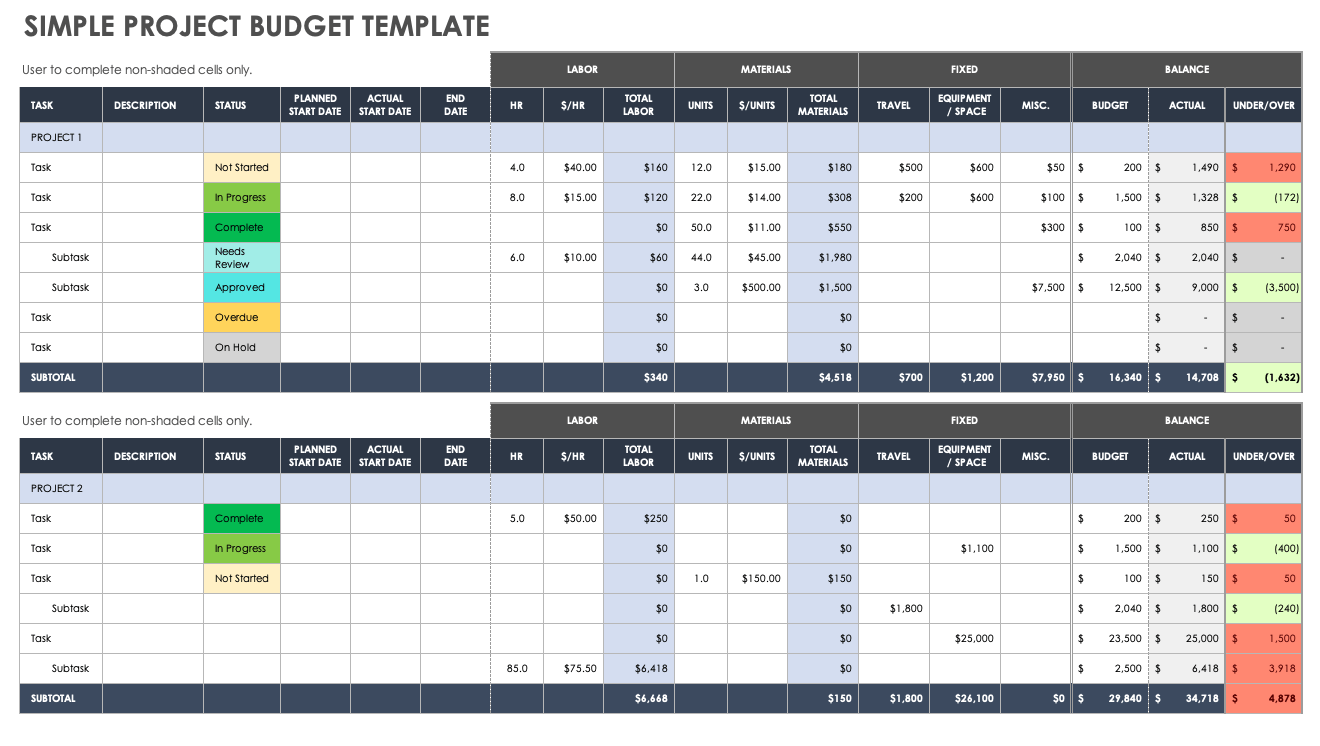
Use one of these project budget templates to maintain control over project finances, ensuring costs stay aligned with the allocated budget and improving overall financial management.
Free Monthly Budget Templates
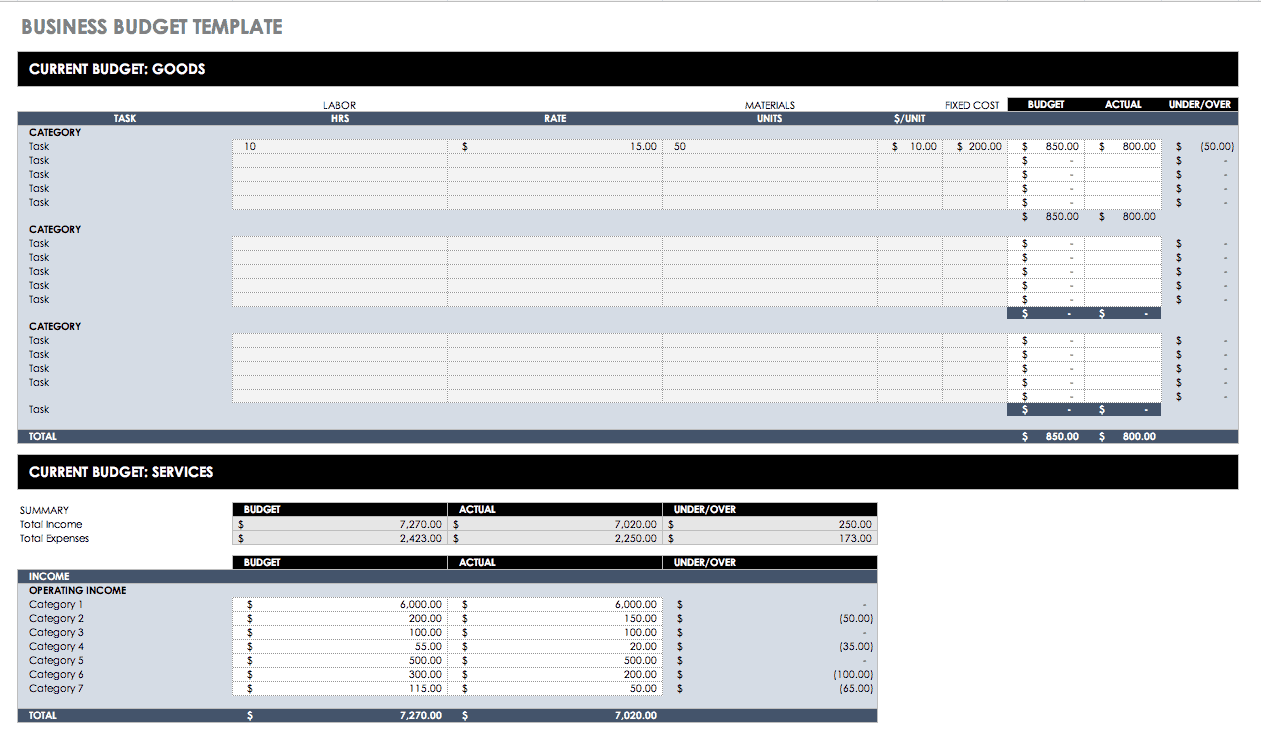
Use one of these monthly budget templates to effectively track and manage your business’s income and expenses, helping you plan financially and save money.
Free Expense Report Templates
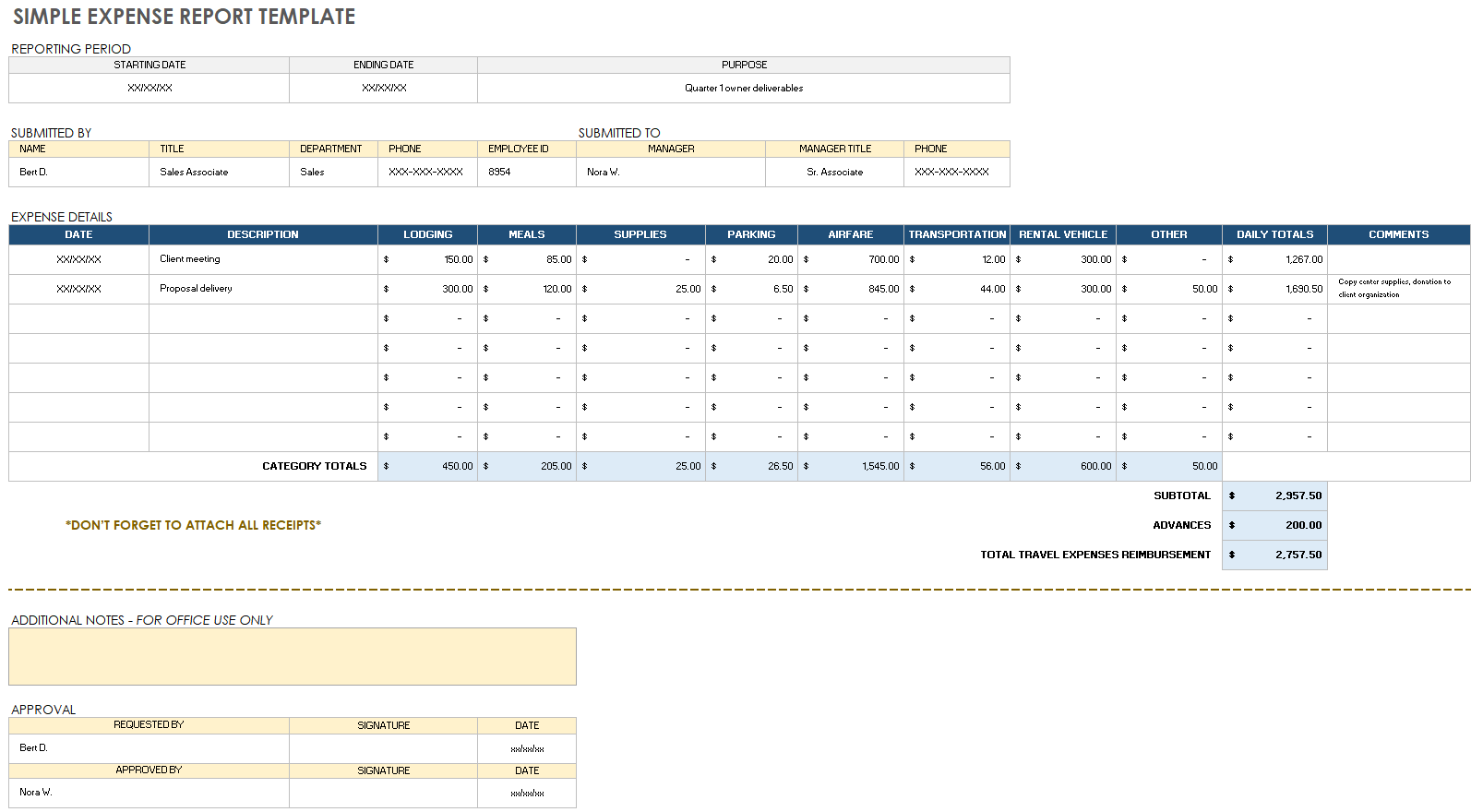
Use one of these expense report templates to systematically track and document all business-related expenditures, ensuring accurate reimbursement and efficient financial record-keeping.
Free Balance Sheet Templates
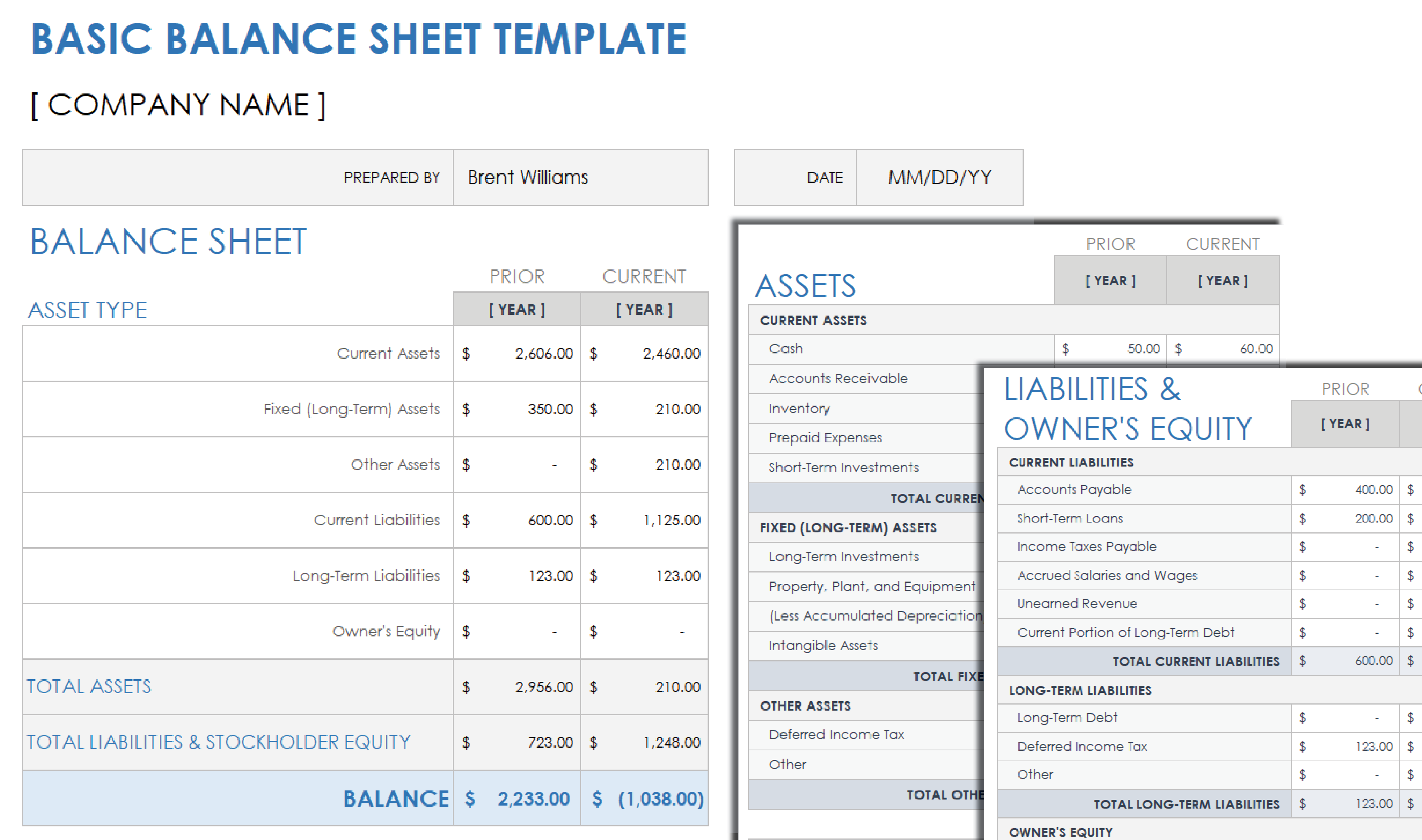
Use one of these balance sheet templates to summarize your company's financial position at a given time.
Free Cash-Flow Forecast Templates
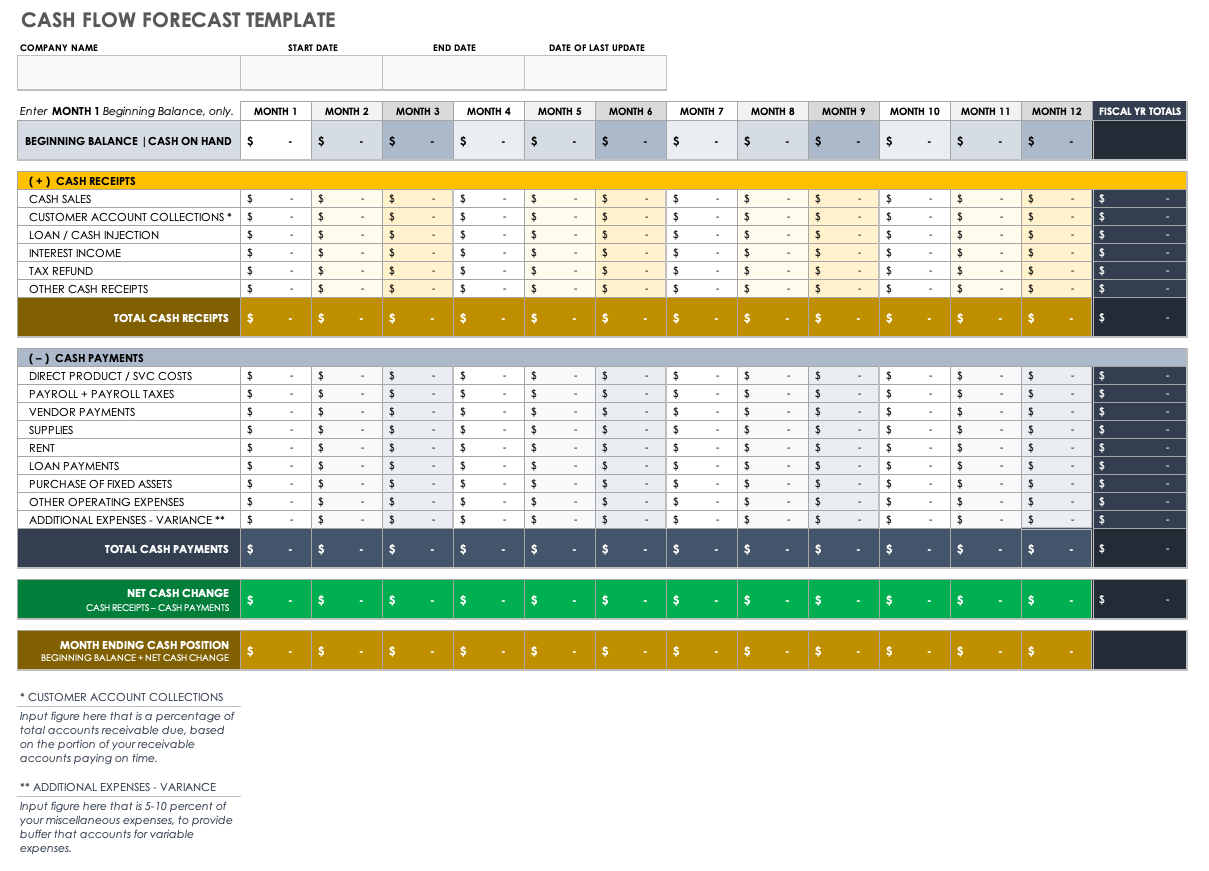
Use one of these cash-flow forecast templates to predict future cash inflows and outflows, helping you manage liquidity and make informed financial decisions.
Free Cash-Flow Statement Templates

Use one of these cash-flow statement templates to track the movement of cash in and out of your business, so you can assess your company’s level of liquidity and financial stability.
Free Discounted Cash-Flow (DCF) Templates
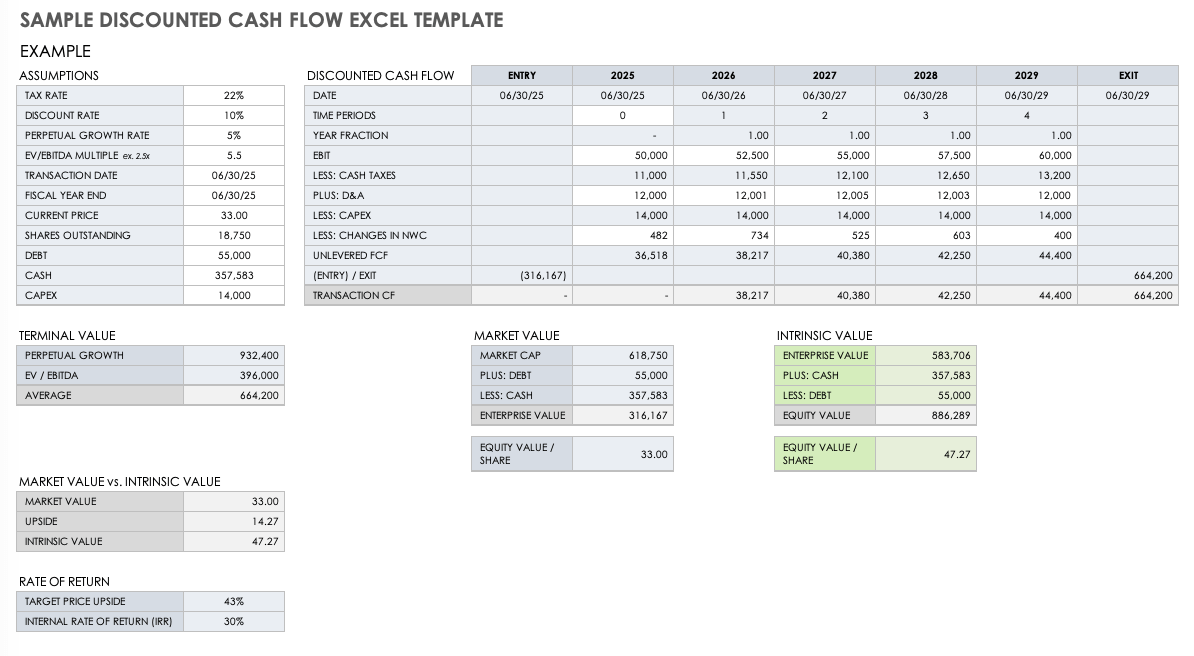
Use one of these discounted cash-flow (DCF) templates to evaluate the profitability of investments or projects by calculating their present value based on future cash flows.
Free Financial Dashboard Templates
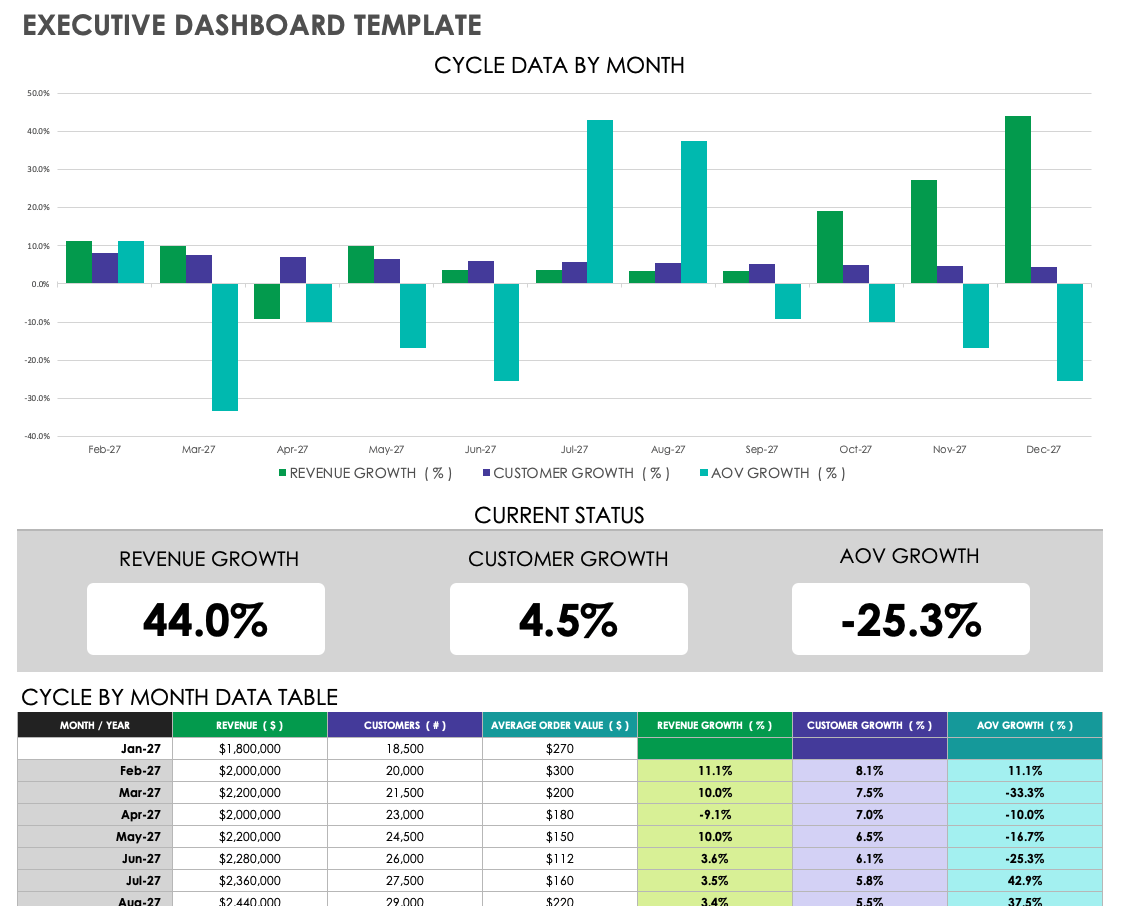
Use one of these financial dashboard templates to get an at-a-glance view of key financial metrics, so you can make decisions quickly and manage finances effectively.
Related Customer Stories
Free financial planning templates.
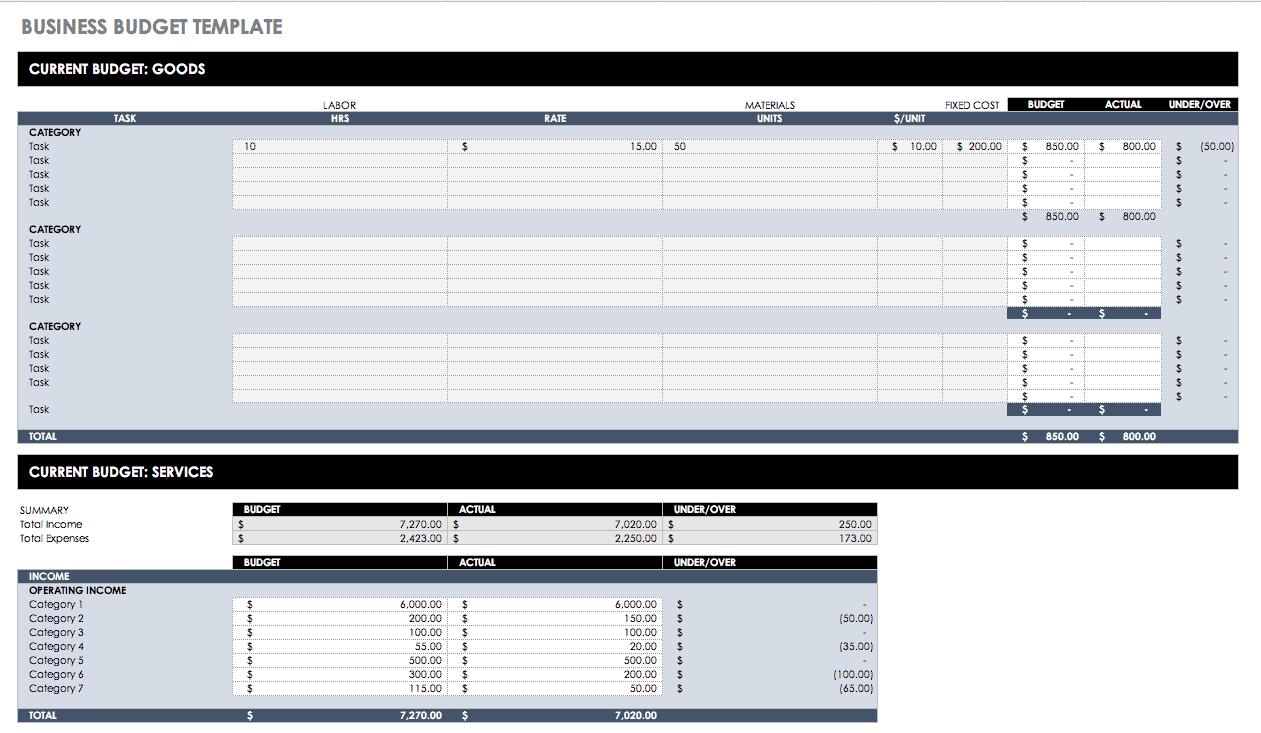
Use one of these financial planning templates to strategically organize and forecast future finances, helping you set realistic financial goals and ensure long-term business growth.
Free Profit and Loss (P&L) Templates
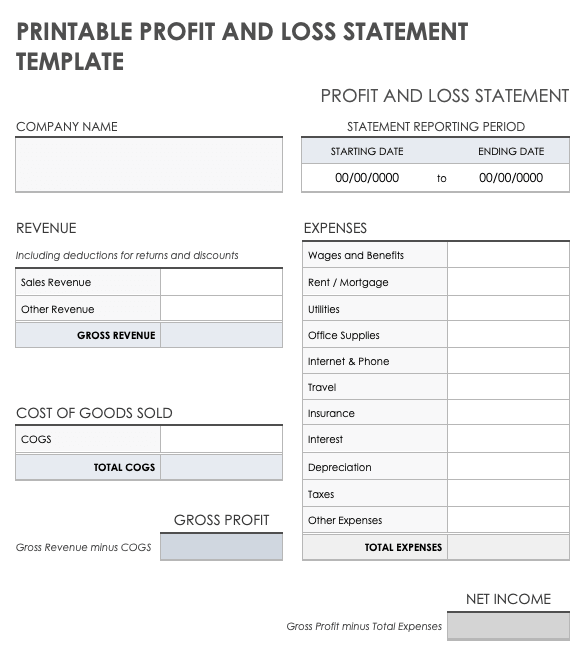
Use one of these profit and loss (P&L) templates to systematically track income and expenses, giving you a clear picture of your company's profitability over a specific period.
Free Billing and Invoice Templates
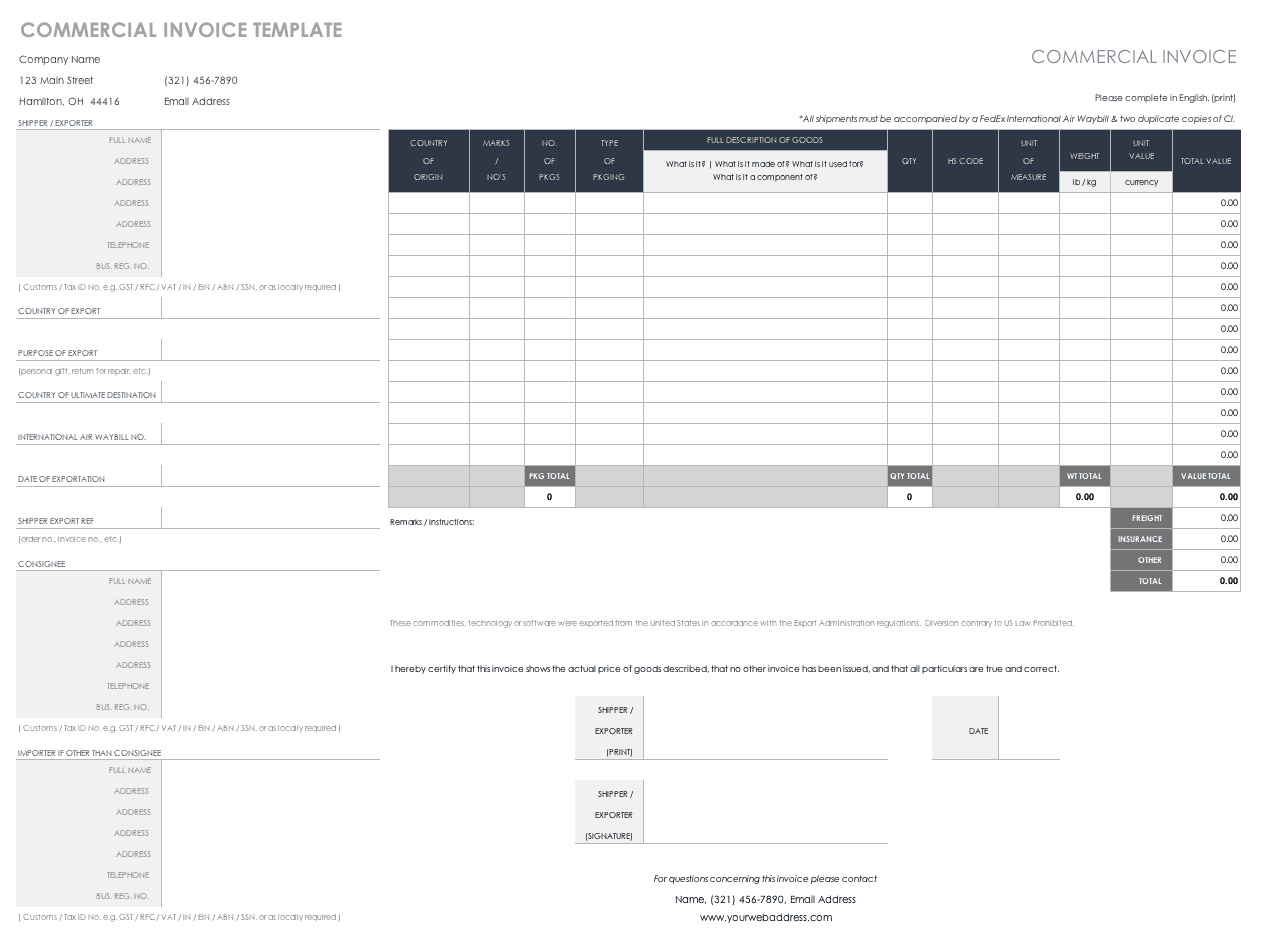
Use one of these billing and invoice templates to streamline the invoicing process and ensure that you bill clients accurately and professionally for services or products.
Plan and Manage Your Company’s Financial Future with Financial Projection and Forecasting Templates from Smartsheet
Empower your people to go above and beyond with a flexible platform designed to match the needs of your team — and adapt as those needs change.
The Smartsheet platform makes it easy to plan, capture, manage, and report on work from anywhere, helping your team be more effective and get more done. Report on key metrics and get real-time visibility into work as it happens with roll-up reports, dashboards, and automated workflows built to keep your team connected and informed.
When teams have clarity into the work getting done, there’s no telling how much more they can accomplish in the same amount of time. Try Smartsheet for free, today.
Discover why over 90% of Fortune 100 companies trust Smartsheet to get work done.
ZenBusinessPlans
Home » Business Plans
How to Write a Business Plan Financial Projection [Sample Template]

How do you prepare a business plan financial statement? Do you need help developing business plan financial projections? Do you need a business plan projections template? Then i advice you read on because this article is for you.
What is a Business Plan Financial Statement?
The financial statement is a distinct section of your business plan because it outlines your financial projections. A business lives and dies based on its financial feasibility and most importantly its profitability. Regardless of how hard you work or how much you have invested of your time and money, people, at the end of the day, only want to support something that can return their investments with profits.
Your executive summary may be brilliantly crafted, and your market or industry analysis may be the bomb. But your business plan isn’t just complete without a financial statement to justify it with good figures on the bottom line.
Your financial statement is what makes or mars your chances of obtaining a bank loan or attracting investors to your business. Even if you don’t need financing from a third party, compiling a financial statement will help you steer your business to success. So, before we dig further into how to prepare a financial statement, you need to understand what a financial statement is not.
What’s the Difference Between a Financial Projection Statement and Accounting Statement?
However, you need to keep in mind that the financial statement is not the same as an accounting statement. Granted, a financial statement includes financial projections such as profit and loss, balance sheets, and cash flow, all of which makes it look similar to an accounting statement.
But the major difference between them is that an accounting statement deals with the past, while the financial projections statement of your business plan outlines your future spending and earnings. Having made this point clear, let’s now look at the steps involved on preparing a financial statement for your business plan.
So what exactly do you have to include in this section? You will need to include three statements:
- Income Statement
- Balance Sheet
- Cash-Flow Statement
Now, let’s briefly discuss each.
Components of a Business Plan Financial Statement
Income statement.
This beautiful composition of numbers tells the reader what exactly your sources of revenue are and which expenses you spent your money on to arrive at the bottom line. Essentially, for a given time period, the income statement states the profit or loss ( revenue-expenses ) that you made.
Balance sheet
The key word here is “ balance, ” but you are probably wondering what exactly needs to be weighed, right? On one side you should list all your assets ( what you own ) and on the other side, all your liabilities ( what you owe ), thereby giving a snapshot of your net worth ( assets – liabilities = equity ).
Cash flow statement
This statement is similar to your income statement with one important difference; it takes into account just when revenues are actually collected and when expenses are paid. When the cash you have coming in ( collected revenue ) is greater than the cash you have going out ( disbursements ), your cash flow is said to be positive.
And when the opposite scenario is true, your cash flow is negative. Ideally, your cash flow statement will allow you to recognize where cash is low, when you might have a surplus, and how to be on top of your game when operating in an uncertain environment.
How to Prepare a Business Plan Financial Projections Statement

1. Start by preparing a revenue forecast and a forecast profit and loss statement
Also, prepare supporting schedules with detailed information about your projected personnel and marketing costs. If your business has few fixed assets or it’s just a cash business without significant receivables, you don’t need a forecast balance sheet.
2. Using your planned revenue model, prepare a spreadsheet
Set the key variables in such a way that they can be easily changed as your calculations chain through. To ensure that your projected revenues are realistic and attainable, run your draft through a number of iterations. For each year covered in your business plan, prepare a monthly forecast of revenues and spending.
3. If you plan to sell any goods, then include a forecast of goods sold
This applies the most to manufacturing businesses. Give a reasonable estimate for this cost. And be of the assumption that the efficiency of your products would increase with time and the cost of goods sold as a percentage of sales will decline.
4. Quantify your marketing plan
Look at each marketing strategy you outlined in the business plan and attach specific costs to each of them. That is, if you are looking at billboard advertising, TV advertising, and online marketing methods such as pay-per-click advertising and so on; then you should estimate the cost of each medium and have it documented.
5. Forecast the cost of running the business, including general and administrative costs
Also, forecast the cost of utilities, rents, and other recurring costs. Don’t leave out any category of expenses that is required to run your business. And don’t forget the cost of professional services such as accounting and legal services.
6. In the form of a spreadsheet, forecast the payroll
This outlines each individual that you plan to hire, the month they will start work, and their salary. Also include the percentage salary increases (due to increased cost of living and as reward for exemplary performance) that will come in the second and subsequent years of the forecast.
Additional tips for Writing a Business Plan Financial Statement
- Don’t stuff your pages with lots of information, and avoid large chunks of text. Also, use a font size that is large enough. Even if these would spread out your statement into more pages, don’t hesitate to spread it out. Legibility matters!
- After completing the spreadsheets in the financial statement, you should summarize the figures in the narrative section of your business plan.
- Put a table near the front of your financial statement that shows projected figures, pre-tax profit, and expenses. These are the figures you want the reader to remember. You can help the reader retain these figures in memory by including a bar chart of these figures, too.
As a final note, you should keep in mind that a financial statement is just an informed guess of what will likely happen in the future. In reality, the actual results you will achieve will vary. In fact, this difference may be very far from what you have forecast.
So, if your business is a start-up, prepare more capital than your projections show that you will need. Entrepreneurs have a natural tendency to project a faster revenue growth than what is realistic. So, don’t let this instinct fool you.
More on Business Plans
Original text

Financial projections use existing or estimated financial data to forecast your business’s future income and expenses. They often include different scenarios to see how changes to one aspect of your finances (such as higher sales or lower operating expenses) might affect your profitability.
If you need to create financial projections for a startup or existing business, this free, downloadable template includes all the necessary tools.
What Are Financial Projections Used for?
Financial projections are an essential business planning tool for several reasons.
- If you’re starting a business, financial projections help you plan your startup budget, assess when you expect the business to become profitable, and set benchmarks for achieving financial goals.
- If you’re already in business, creating financial projections each year can help you set goals and stay on track.
- When seeking outside financing, startups and existing businesses need financial projections to convince lenders and investors of the business’s growth potential.
What’s Included in Financial Projections?
This financial projections template pulls together several different financial documents, including:
- Startup expenses
- Payroll costs
- Sales forecast
- Operating expenses for the first 3 years of business
- Cash flow statements for the first 3 years of business
- Income statements for the first 3 years of business
- Balance sheet
- Break-even analysis
- Financial ratios
- Cost of goods sold (COGS), and
- Amortization and depreciation for your business.
You can use this template to create the documents from scratch or pull in information from those you’ve already made. The template also includes diagnostic tools to test the numbers in your financial projections and ensure they are within reasonable ranges.
These areas are closely related, so as you work on your financial projections, you’ll find that changes to one element affect the others. You may want to include a best-case and worst-case scenario for all possibilities. Make sure you know the assumptions behind your financial projections and can explain them to others.
Startup business owners often wonder how to create financial projections for a business that doesn’t exist yet. Financial forecasts are continually educated guesses. To make yours as accurate as possible, do your homework and get help. Use the information you unearthed in researching your business plans, such as statistics from industry associations, data from government sources, and financials from similar businesses. An accountant with experience in your industry can help fine-tune your financial projections. So can business advisors such as SCORE mentors.
Once you complete your financial projections, don’t put them away and forget about them. Compare your projections to your financial statements regularly to see how well your business meets your expectations. If your projections turn out to be too optimistic or too pessimistic, make the necessary adjustments to make them more accurate.
*NOTE: The cells with formulas in this workbook are locked. If changes are needed, the unlock code is "1234." Please use caution when unlocking the spreadsheets. If you want to change a formula, we strongly recommend saving a copy of this spreadsheet under a different name before doing so.
We recommend downloading the Financial Projections Template Guide in English or Espanol .
Do you need help creating your financial projections? Take SCORE’s online course on-demand on financial projections or connect with a SCORE mentor online or in your community today.
Simple Steps for Starting Your Business: Financial Projections In this online module, you'll learn the importance of financial planning, how to build your financial model, how to understand financial statements and more.
Business Planning & Financial Statements Template Gallery Download SCORE’s templates to help you plan for a new business startup or grow your existing business.
Why Projected Financial Statements Are Essential to the Future Success of Startups Financial statements are vital to the success of any company but particularly start-ups. SCORE mentor Sarah Hadjhamou shares why they are a big part of growing your start-up.
Copyright © 2024 SCORE Association, SCORE.org
Funded, in part, through a Cooperative Agreement with the U.S. Small Business Administration. All opinions, and/or recommendations expressed herein are those of the author(s) and do not necessarily reflect the views of the SBA.
- Search Search Please fill out this field.
- Corporate Finance
- Financial Analysis
What Is Business Forecasting? Definition, Methods, and Model
:max_bytes(150000):strip_icc():format(webp)/andy__andrew_beattie-5bfc262946e0fb005143d642.jpg)
What Is Business Forecasting?
Business forecasting involves making informed guesses about certain business metrics, regardless of whether they reflect the specifics of a business, such as sales growth, or predictions for the economy as a whole. Financial and operational decisions are made based on economic conditions and how the future looks, albeit uncertain.
Key Takeaways:
- Forecasting is valuable to businesses so that they can make informed business decisions.
- Financial forecasts are fundamentally informed guesses, and there are risks involved in relying on past data and methods that cannot include certain variables.
- Forecasting approaches include qualitative models and quantitative models.
Understanding Business Forecasting
Companies use forecasting to help them develop business strategies. Past data is collected and analyzed so that patterns can be found. Today, big data and artificial intelligence has transformed business forecasting methods. There are several different methods by which a business forecast is made. All the methods fall into one of two overarching approaches: qualitative and quantitative .
While there might be large variations on a practical level when it comes to business forecasting, on a conceptual level, most forecasts follow the same process:
- A problem or data point is chosen. This can be something like "will people buy a high-end coffee maker?" or "what will our sales be in March next year?"
- Theoretical variables and an ideal data set are chosen. This is where the forecaster identifies the relevant variables that need to be considered and decides how to collect the data.
- Assumption time. To cut down the time and data needed to make a forecast, the forecaster makes some explicit assumptions to simplify the process.
- A model is chosen. The forecaster picks the model that fits the dataset, selected variables, and assumptions.
- Analysis. Using the model, the data is analyzed, and a forecast is made from the analysis.
- Verification. The forecast is compared to what actually happens to identify problems, tweak some variables, or, in the rare case of an accurate forecast, pat themselves on the back.
Once the analysis has been verified, it must be condensed into an appropriate format to easily convey the results to stakeholders or decision-makers. Data visualization and presentation skills are helpful here.
Types of Business Forecasting
There are two key types of models used in business forecasting—qualitative and quantitative models.
Qualitative Models
Qualitative models have typically been successful with short-term predictions, where the scope of the forecast was limited. Qualitative forecasts can be thought of as expert-driven, in that they depend on market mavens or the market as a whole to weigh in with an informed consensus.
Qualitative models can be useful in predicting the short-term success of companies, products, and services, but they have limitations due to their reliance on opinion over measurable data. Qualitative models include:
- Market research : Polling a large number of people on a specific product or service to predict how many people will buy or use it once launched.
- Delphi method : Asking field experts for general opinions and then compiling them into a forecast.
Quantitative Models
Quantitative models discount the expert factor and try to remove the human element from the analysis. These approaches are concerned solely with data and avoid the fickleness of the people underlying the numbers. These approaches also try to predict where variables such as sales, gross domestic product , housing prices, and so on, will be in the long term, measured in months or years. Quantitative models include:
- The indicator approach : The indicator approach depends on the relationship between certain indicators, for example, GDP and the unemployment rate remaining relatively unchanged over time. By following the relationships and then following leading indicators, you can estimate the performance of the lagging indicators by using the leading indicator data.
- Econometric modeling : This is a more mathematically rigorous version of the indicator approach. Instead of assuming that relationships stay the same, econometric modeling tests the internal consistency of datasets over time and the significance or strength of the relationship between datasets. Econometric modeling is applied to create custom indicators for a more targeted approach. However, econometric models are more often used in academic fields to evaluate economic policies.
- Time series methods : Time series use past data to predict future events. The difference between the time series methodologies lies in the fine details, for example, giving more recent data more weight or discounting certain outlier points. By tracking what happened in the past, the forecaster hopes to get at least a better than average view of the future. This is one of the most common types of business forecasting because it is inexpensive and no better or worse than other methods.
Criticism of Forecasting
Forecasting can be dangerous. Forecasts become a focus for companies and governments mentally limiting their range of actions by presenting the short to long-term future as pre-determined. Moreover, forecasts can easily break down due to random elements that cannot be incorporated into a model, or they can be just plain wrong from the start.
But business forecasting is vital for businesses because it allows them to plan production, financing, and other strategies. However, there are three problems with relying on forecasts:
- The data is always going to be old. Historical data is all we have to go on, and there is no guarantee that the conditions in the past will continue in the future.
- It is impossible to factor in unique or unexpected events, or externalities . Assumptions are dangerous, such as the assumption that banks were properly screening borrowers prior to the subprime meltdown . Black swan events have become more common as our reliance on forecasts has grown.
- Forecasts cannot integrate their own impact. By having forecasts, accurate or inaccurate, the actions of businesses are influenced by a factor that cannot be included as a variable. This is a conceptual knot. In a worst-case scenario, management becomes a slave to historical data and trends rather than worrying about what the business is doing now.
Negatives aside, business forecasting is here to stay. Appropriately used, forecasting allows businesses to plan ahead for their needs, raising their chances of staying competitive in the markets. That's one function of business forecasting that all investors can appreciate.
Kesh, Someswar and Raja, M.K. "Development of a Qualitative Reasoning Model for Financial Forecasting." Information Management & Computer Security, vol. 13, no. 2, 2005, pp. 167-179.
Infiniti Research. " Business Forecasting: The Challenges in Knowing the Unknown ."
:max_bytes(150000):strip_icc():format(webp)/GettyImages-699097865-5914251597ff43a1b2e59a0c3cecc660.jpg)
- Terms of Service
- Editorial Policy
- Privacy Policy
- Your Privacy Choices
What's Planergy?
Modern Spend Management and Accounts Payable software.
Helping organizations spend smarter and more efficiently by automating purchasing and invoice processing.
We saved more than $1 million on our spend in the first year and just recently identified an opportunity to save about $10,000 every month on recurring expenses with Planergy.

Cristian Maradiaga
Download a free copy of "preparing your ap department for the future", to learn:.
- How to transition from paper and excel to eInvoicing.
- How AP can improve relationships with your key suppliers.
- How to capture early payment discounts and avoid late payment penalties.
- How better management in AP can give you better flexibility for cash flow management.
Business Plan Financial Projections: How To Create Accurate Targets
- Written by Keith Murphy
- 16 min read

Small businesses and startups have a lot riding on their ability to create effective and accurate financial projections as part of their business plan. Solid financials are a strong enticement for investors, after all, and can help new businesses chart a course that will take them beyond the legendendarily difficult first year and into a productive and profitable future.
But the need for business owners to look ahead in order to secure funding, increase profits, and make intelligent financial decisions doesn’t end when startups become full-fledged businesses—and business plan financial projections aren’t just for startups. Existing businesses can also put them to good use by harvesting insights from their existing financial statements and creating sales projections and other financial forecasts that guide and improve their ongoing business planning.
What Are Business Plan Financial Projections?
Successful companies plan ahead, looking as best they can into the near and distant future to chart a course to growth, innovation, and competitive strength. Financial projections, both as part of an initial business plan and as part of ongoing business planning, use a company’s financial statements to help business owners forecast their upcoming expenses and revenue in a strategically useful way.
Most businesses use two types of financial projections:
- Short-term projections are broken down by month and generally cover the coming 12 months. They provide a guide companies can use to monitor and adjust their financial activity to set and hit targets for the financial year. In the first year, short-term projections will be entirely estimated, but in subsequent years, historical data can be used to help fine-tune them for greater accuracy and strategic utility.
- Long-term projections are focused on the coming three to five years and are generally used to secure investment (both initial and ongoing), provide a strategic roadmap for the company’s growth, or both.
For startups, creating financial projections is part of their initial business plan. Providing financial forecasts banks and potential investors can use to determine the financial viability of a business is key to obtaining financing and investments needed to get the business off the ground.
For existing businesses—for whom an initial business plan has evolved into business planning—financial projections are useful in attracting investors who want to see clear estimates for upcoming revenue, expenses, and potential growth. They’re also helpful in securing loans and lines of credit from financial institutions for the same reason. And even if you’re not trying to get funding or investments, financial projections provide a useful framework for building budgets focused on growth and competitive advantage.
So whether you’re a small business owner, an aspiring tycoon starting a new business, or part of the financial team at a well-established corporation, what matters most is viewing financial projections as a living, breathing reference tool that can help you plan and budget for growth in a realistic way while still setting aspirational goals for your business.
Financial projections, both as part of an initial business plan and as part of ongoing business planning, use a company’s financial statements to help business owners forecast their upcoming expenses and revenue in a strategically useful way.
Financial Projections: Core Components
Whether you’re preparing them as part of your business plan or to enhance your business planning, you’ll need the same financial statements to prepare financial projections: an income statement, a cash-flow statement, and a balance sheet.
- Income statements , sometimes called profit and loss statements , provide detailed information on your company’s revenue and expenses for a given period (e.g., a quarter, year, or multi-year period).
- Cash flow statements provide a comprehensive view of cash flowing into and out of a business. They record all cash flow from operations, investment, and financing activities.
- Balance sheets are used to showcase a company’s assets, liabilities, and owner’s equity for a specific period.
How to Create Financial Projections
The process of creating financial projections is the same whether you’re drafting a business plan or creating forecasts for an existing business. The primary difference is whether you’ll draw on your own research and expertise (a new business or startup business) or use historical data (existing businesses).
Keep in mind that while you’ll create the necessary documents separately, you’ll most likely finish them by consulting each of them as needed. For example, your sales forecast might change once you prepare your cash-flow statement. The best approach is to view each document as both its own piece of the financial projection puzzle and a reference for the others; this will help ensure you can assemble comprehensive and clear financial projections.
1. Start with a Sales Projection
A sales forecast is the first step in creating your income statement. You can start with a one, three, or five-year projection, but keep in mind that, without historical financial data, accuracy may decrease over time. It’s best to start with monthly income statements until you reach your projected break-even , which is the point at which revenue exceeds total operating expenses and you show a profit. Once you hit the break-even, you can transition to annual income statements.
Also, keep in mind factors outside of sales; market conditions, global environmental, political, and health concerns, sourcing challenges (including pricing changes and increased variable costs) and other business disruptors can put the kibosh on your carefully constructed forecasts if you leave them out of your considerations.
Start with a reasonable estimate of the units sold for the forecast period, and multiply them by the price per unit. This value is your total sales for the period.
Next, estimate the total cost of producing these units (i.e., the cost of goods sold , or COGS; sometimes called cost of sales ) by multiplying the per-unit cost by the number of units produced.
Deducting your COGS from your estimated sales yields your gross profit margin.
From the gross margin, subtract expenses such as wages, marketing costs, rent, and other operating expenses. The result is your projected operating income , or net income .
Using these figures, you can create an income statement:
2. Cash Flow Statement
Tracking your estimated cash inflows and outflows from investment and financing, combined with the cash generated by business operations, is the purpose of a cash flow projection .
Investment activities might include, for example, purchasing real estate or investing in research and development outside of daily operations.
Financing activities include cash inflows from investor funding or business loans, as well as cash outflows to repay debts or pay dividends to shareholders.
A reliable and accurate cash flow projection is essential to managing your working capital effectively and ensuring you have all the cash you need to cover your ongoing obligations while still having enough left to invest in growth and innovation or cover emergencies.
Drawing from our income statement, we can create a basic cash flow statement:
3. The Balance Sheet
Providing a “snapshot” of your businesses’ financial performance for a given period of time, the balance sheet contains your company’s assets, liabilities, and owner’s equity.
Assets include inventory, real estate, and capital, while liabilities represent financial obligations and include accounts payable, bank loans, and other debt.
Owner’s equity represents the amount remaining once liabilities have been paid.
Ideally, over time your company’s balance sheet will reflect your growth through a reduction of liabilities and an increase in owner’s equity.
We can complete our triumvirate of financial statements with a basic balance sheet:
Best Practices for Effective Financial Projections
Like a lot of other business processes, financial planning can be complex, time-consuming, and even frustrating if you’re still using manual workflows and paper documents or basic spreadsheet-style applications such as Microsoft Excel. You can get free templates for basic financial projections from the Service Corps of Retired Executives (SCORE), but even templates can only take you so far.
Without a doubt, the best advantage you can give yourself in creating effective and accurate financial projections—whether they’re for the financial section of your business plan or simply part of your ongoing business planning—is to invest in comprehensive procure-to-pay (P2P) software such as Planergy.
In addition to helpful templates, best-in-class P2P software also provides a rich array of real-time data analysis, reporting, and forecasting tools that make it easy to transform historical data (or market research) into accurate forecasts. In addition, artificial intelligence and process automation make it easy to collect, organize, manage and share your data with all internal stakeholders, so everyone has the information they need to create the most useful and complete forecasts and projections possible.
Beyond investing in P2P software, you can also improve the quality and accuracy of your financial projections by:
- Doing your homework. Invest in financial statement analysis and ratio analysis, with a focus not just on your own company, but your industry and the market in general. Learn the current ratios used for liquidity analysis, profitability, and debt and compare them to your own to get a more nuanced and useful understanding of how your company performs internally and within the context of the marketplace.
- Keeping it real. It can be all too easy to get carried away with pie-in-the-sky optimism when forecasting the future of your business. Rose-colored glasses aren’t exclusive to startups and small businesses; over-inflated estimates can hobble even veteran organizations if they don’t practice good data discipline and temper their hopes with practical considerations. Focus on creating realistic, but positive, projections, and you won’t have to worry about investors or lenders glancing askance at your hard work.
- Hoping for the best, but planning for the worst. Run two scenarios when performing your financial projections: the best-case scenario where everything goes perfectly to plan, and a worse-case scenario where Murphy’s Law holds sway. While actual performance will undoubtedly fall somewhere in between the two, having an upper and lower boundary appeals to investors and lenders who are assessing your company’s financial viability.
Financial Projections Help You Reach Your Goals for Growth
From startups to global corporations, every business needs reliable tools for financial forecasting. Take the time to create well-researched, data-driven financial projections, and you’ll be well-equipped to attract investors, secure funding, and chart a course for greater profits, growth, and performance in today’s competitive marketplace.
What’s your goal today?
1. use planergy to manage purchasing and accounts payable.
- Read our case studies, client success stories, and testimonials.
- Visit our “Solutions” page to see the areas of your business we can help improve to see if we’re a good fit for each other.
- Learn about us, and our long history of helping companies just like yours.
2. Download our guide “Preparing Your AP Department For The Future”
3. learn best practices for purchasing, finance, and more.
Browse hundreds of articles , containing an amazing number of useful tools, techniques, and best practices. Many readers tell us they would have paid consultants for the advice in these articles.
Related Posts

The Future of FP&A: How The Role Is Evolving With The Use Of Real-Time Data
- 17 min read

Days Sales Outstanding: What Is It and How To Calculate It
- 19 min read

Budgeting In UK Schools: MAT, Academy Budgeting Challenges and Best Practices
Procurement.
- Purchasing Software
- Purchase Order Software
- Procurement Solutions
- Procure-to-Pay Software
- E-Procurement Software
- PO System For Small Business
- Spend Analysis Software
- Vendor Management Software
- Inventory Management Software
AP & FINANCE
- Accounts Payable Software
- AP Automation Software
- Compliance Management Software
- Business Budgeting Software
- Workflow Automation Software
- Integrations
- Reseller Partner Program
Business is Our Business
Stay up-to-date with news sent straight to your inbox
Sign up with your email to receive updates from our blog
This website uses cookies
We use cookies to personalise content and ads, to provide social media features and to analyse our traffic. We also share information about your use of our site with our social media, advertising and analytics partners who may combine it with other information that you’ve provided to them or that they’ve collected from your use of their services.
Read our privacy statement here .
How to Forecast Your Project Margins with Resource Planning

SHARE THIS ARTICLE

Boosting project margins isn’t solely about increasing revenue — it’s about securing a brighter financial future for your projects and your firm. This approach allows you to invest in project resources, attract top talent, broaden project scopes, and tackle more ambitious projects, laying the groundwork for long-term success.
By forecasting project margins with resource planning software, organizations can pinpoint areas for improvement and optimize resource allocation, leading to informed decisions that enhance profitability and increase margins over time.
Sounds great, right? That’s why we’ve put together this article to guide professionals like you in forecasting project margins with the assistance of resource planning software, so you can start enjoying these benefits.
Project Margin Definition
A project margin refers to the difference between the revenue generated by a project and the total costs incurred in executing that project. It represents the profit earned from the project and is a key metric used to assess the financial performance and success of the project.
Project Margin vs Profit Margin: What’s the Difference?
For professional services, the distinction between project margin and profit margin is important. Project margin assesses the profitability of individual projects by comparing their earnings with costs incurred, offering insights into project-specific financial health.
On the other hand, profit margin evaluates the overall profitability of a professional services firm by comparing total earnings with total expenses, providing a broader view of the company’s financial standing.
How to Calculate Project Margin Percentage
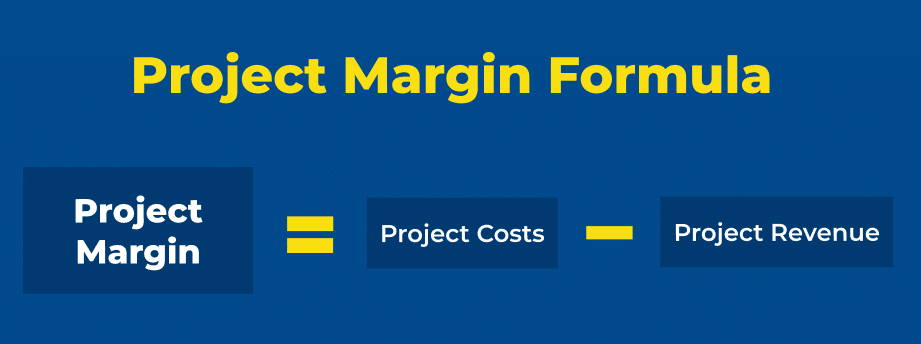
- Project revenue is the total income generated from the project.
- Project costs are all the expenses incurred in executing the project, including labor, materials, overhead costs, and any other direct or indirect expenses.
What’s a good project margin for a professional services company?
A good project margin for a professional services company typically varies depending on industry, market conditions, overhead costs, business objectives, and other factors.
However, as a general guideline, many professional services companies aim for project margins in the range of 20% to 30%.
This range allows for covering direct project costs, including labor, materials, and overhead, while also generating a reasonable profit. Some companies may achieve higher margins if they specialize in niche services or have optimized their operations for efficiency. On the flip side, other companies may operate with lower margins due to things like intense competition or high overhead expenses.
Why forecast project margins?
Forecasting project margins is crucial for professional services firms as it gives important insights for better financial management and decision-making.
By accurately predicting project margins, firms can:
Enhance financial planning: Forecasted margins allow firms to create precise budgets and allocate resources efficiently, ensuring that financial strategies align with business objectives.
Manage risks: Anticipating project margins enables firms to identify potential risks early, empowering them to implement proactive measures to mitigate challenges and safeguard profitability, even in uncertain market conditions.
Optimize resource allocation: Forecasting margins helps firms optimize resource allocation, minimizing waste and maximizing returns on investment.
Inform strategic decisions: Accurate margin forecasts inform strategic decisions across project management and business operations, guiding pricing strategies, resource allocation, and project prioritization to improve profitability and competitiveness.
Maintain client relationships: Realistic margin forecasts enable firms to set transparent expectations for clients regarding project timelines and costs, fostering trust and strengthening long-term relationships.
10 Ways Resource Planning Software Helps Forecast Project Margins
Resource planning is about assigning the right resources to the right project at the right time to have projects run smoothly and within budget. Resource planning ensures that projects are executed efficiently and effectively, ultimately contributing to the overall success of the organization.
Resource planning software, or more commonly known as resource management software is a must-have tool for professional services organizations. Acting as a single source of truth, this software lets users see what resources are available, assign tasks, track how resources are used, and monitor project progress. It also helps with planning, scheduling, and budgeting.

This tool helps organizations with so many aspects of their operations. However, you came here to learn about one benefit in particular — forecasting project margins.
Let’s get into it!
Resource planning software plays an important role in helping professional services firms forecast project margins effectively. Here’s how:
1. Unified Data for Margin Visibility
Fragmented data hampers accurate margin forecasting. Consolidating project-related data into a single platform offers a unified view of resource utilization, project costs, and revenue projections. This consolidated data enables managers to assess project margins accurately and make informed decisions.
2. Accurate Cost Projections
Inaccurate cost projections can skew project margin forecasts. Providing visibility into forecasted costs, including resource expenses and overheads, helps firms estimate margins more effectively and plan accordingly. Additionally, the ability to track historical cost data and compare it with actual expenses allows for continuous improvement in cost estimation accuracy.
3. Optimized Resource Allocation
Efficient resource allocation is essential for maximizing project margins. Facilitating skill-based resource assignments ensures that the right people are allocated to the right projects, minimizing unnecessary costs and improving project profitability. Advanced resource management software can consider factors such as employee expertise, availability, and preferences that can further enhance resource allocation efficiency.
4. Real-Time Margin Monitoring
Monitoring project margins in real time allows for proactive decision-making. Reporting and analytics tools enable managers to track project costs, revenue, and margins as projects progress. This real-time visibility enables timely adjustments to optimize margins and mitigate risks. Additionally, automated alerts can notify stakeholders of any deviations from expected margins, allowing for immediate corrective actions.
5. Scenario Planning for Margin Optimization
Margin forecasting often requires considering various scenarios and contingencies. Conducting scenario planning and simulating different resource allocation strategies, pricing models, and project outcomes, helps identify the most profitable paths and take proactive measures to optimize project margins. A scenario analysis tool can provide comprehensive what-if scenarios and enable firms to assess the impact of different influences on project margins accurately.
6. Capacity Planning
Understanding the team’s workload capacity is crucial. Analyzing factors such as employee availability, skill sets, and project timelines ensures optimal resource allocation, preventing overbooking or underutilization and contributing to accurate margin forecasting. Advanced capacity planning features that consider employee preferences and workload preferences can further improve resource allocation efficiency and employee satisfaction.

7. Data-Driven Decision-Making
Data-driven insights are highlighted through margin forecasting. Providing actionable insights derived from comprehensive data analysis empowers managers to make informed decisions that positively impact project margins. Whether adjusting resource allocations, revising pricing strategies, or optimizing project timelines, data-driven decision-making leads to improved project profits. Predictive analytics capabilities can forecast future margin trends based on historical data, allowing firms to proactively plan for potential changes.
8. Resource Availability Forecasting
Resource availability forecasting tools help firms predict resource availability based on criteria like planned leave, project commitments, and resource utilization rates. By accurately anticipating resource availability, firms can prevent overcommitting resources, reduce project delays, and optimize resource allocation, resulting in improved project margins.
9. Customizable Reporting and Dashboards
Customizable reporting and dashboard functionalities provide insights into project performance, resource utilization, and financial metrics. Tailoring reports and dashboards to specific business needs enables managers to gain actionable insights to optimize project margins and increase profits. These reporting capabilities empower stakeholders to access real-time data and generate customized reports, facilitating data-driven decision-making and improving overall business performance.
10. Client and Project Profitability Analysis
This feature helps firms assess the profitability of clients and projects based on revenue, costs, and resource usage. By identifying high-value clients and projects, firms can allocate resources wisely, maximizing profitability. It also highlights areas for improvement, such as cost reduction strategies, to enhance overall project margins and business performance.
Accurately and Easily Forecast Project Margins with BigTime Foresight
When choosing resource management software, prioritize simplicity without sacrificing effectiveness. BigTime Foresight is a resource management solution that was designed for professional services firms like yours to stay profitable and ahead of the curve. Foresight simplifies complex tasks, allowing users to efficiently manage resources, track project costs, and forecast project margins with precision. Explore BigTime Foresight here or schedule a demo below to see it in action.

Frequently Asked Questions About Project Margins
What is a project margin.
A project margin refers to the difference between the revenue generated from a project and the total costs incurred to complete that project. It represents the profitability of the project and is calculated by subtracting the total costs (including direct and indirect costs) from the total revenue.
What is margin in a project?
In a project, margin refers to the difference between the total revenue generated and the total costs incurred during its execution.
What is a good profit margin for a project?
A good profit margin for a project typically varies depending on factors such as industry standards, project complexity, and market conditions. Generally, a higher profit margin indicates better project profitability.
Can you forecast project margins?
With resource management software, you can forecast project margins by analyzing historical data, considering current project variables, and using predictive analytics to estimate future revenues and costs.
Ready to get started?
Recommended for you
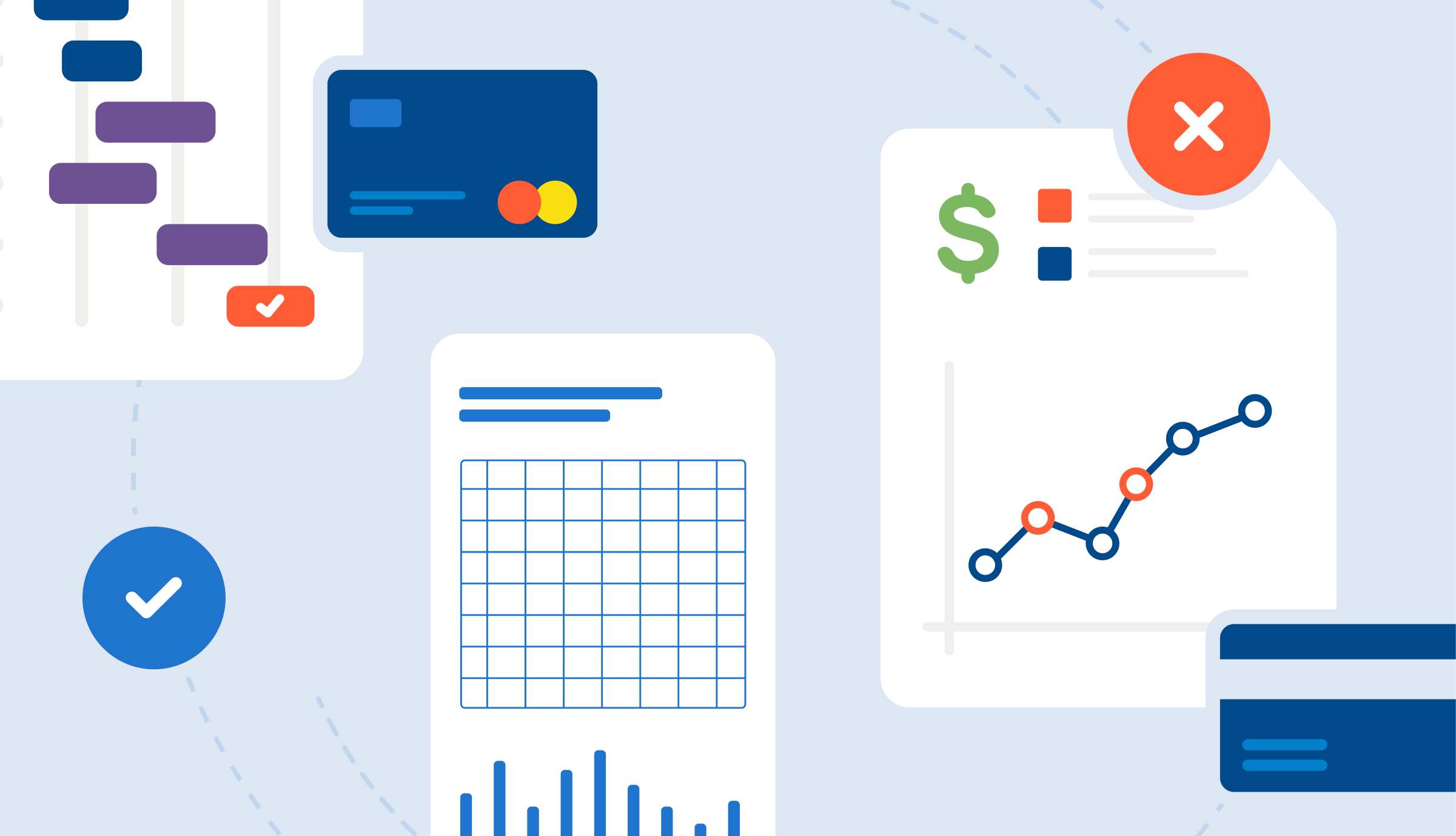
Why Resource Management is Vital to Growing Your Professional Services Business
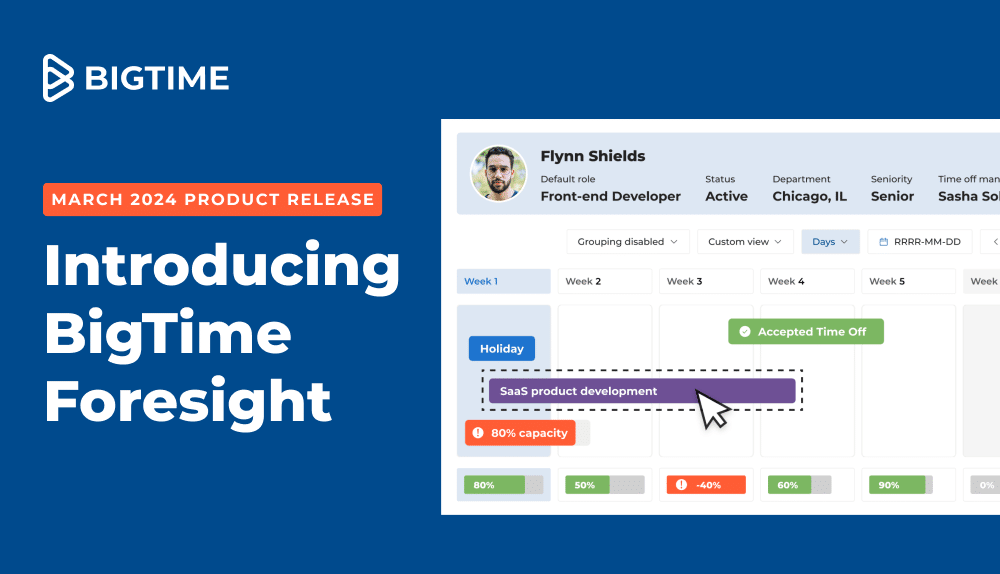
Meet BigTime Foresight: Forward-Looking Resource Management to Ensure Better Financial Outcomes
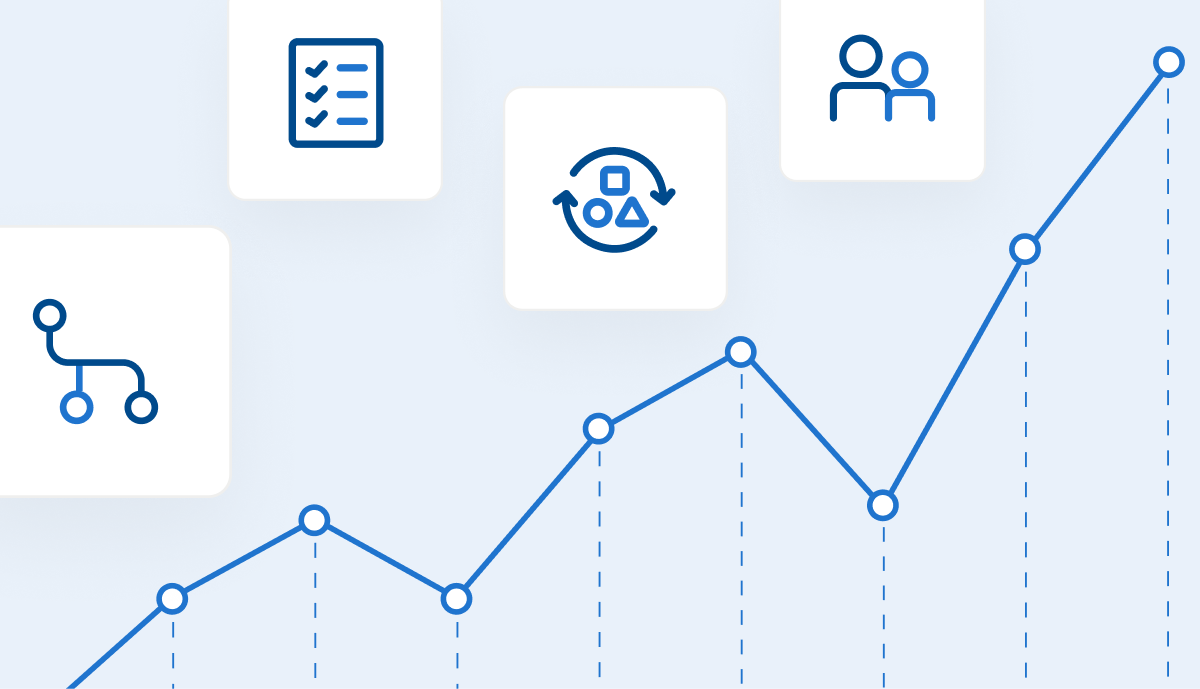
Capacity Planning Software: Reaching Peak Productivity
Rivian sticks to production forecast below Wall Street targets
- Medium Text

- Company Rivian Automotive Inc Follow
- Company Rivian Automotive LLC Follow
- Company Amazon.com Inc Follow

Sign up here.
Reporting by Akash Sriram in Bengaluru and Abhirup Roy in San Francisco; Editing by Shailesh Kuber, Matthew Lewis and Richard Chang
Our Standards: The Thomson Reuters Trust Principles. New Tab , opens new tab

Thomson Reuters
Akash reports on technology companies in the United States, electric vehicle companies, and the space industry. His reporting usually appears in the Autos & Transportation and Technology sections. He has a postgraduate degree in Conflict, Development, and Security from the University of Leeds. Akash's interests include music, football (soccer), and Formula 1.

Business Chevron

US agency opens probe into over 200,000 Ford vehicles on fuel leak risks
The U.S. auto safety regulator said on Friday it was opening a preliminary evaluation into 210,960 Ford vehicles following complaints alleging diesel fuel leaks that may result in a fire.

Watch CBS News
Social Security projected to cut benefits in 2035 barring a fix
By Aimee Picchi
Edited By Alain Sherter
Updated on: May 7, 2024 / 11:28 AM EDT / CBS News
The timeline to replenish Social Security is being extended. The federal retirement program said Monday it may not need to cut benefits until 2035, one year later than previously forecast, because of stronger performance by the U.S.
The new projection, from the Social Security Board of Trustees' annual report, amounts to "good news" for the program's 70 million beneficiaries, said Martin O'Malley, Commissioner of Social Security, in a statement. Even so, he urged Congress to take steps to shore up the program to ensure it can pay full benefits "into the foreseeable future."
Social Security relies on its trust funds to provide monthly checks to beneficiaries, with the funds primarily financed through the payroll taxes that workers and businesses provide with each paycheck. But the funds' reserves are drawing down because spending is outpacing income, partly due to the wave of baby boomer retirements and an aging U.S. population.
Experts underscore that if the trust funds are depleted, benefits won't suddenly disappear. Instead, Social Security beneficiaries will face a cut to their monthly checks, with the agency on Monday projecting that recipients would lose 17% of their current benefits.
That would be painful for millions of retired and disabled Americans, but it represents a modest improvement from last year, when the Social Security Administration projected that benefits could be slashed by 23% if the trust funds reached the point of depletion.
Advocates for older Americans praised the improved outlook, while pressing Congress to take action on shoring up the program.
"Congress owes it to the American people to reach a bipartisan solution, ensuring people's hard-earned Social Security benefits will be there in full for the decades ahead," AARP CEO Jo Ann Jenkins said in a statement. "The stakes are simply too high to do nothing."
Lawmakers have yet to take action despite being aware of the looming funding crisis, noted Maya MacGuineas, president of the Committee for a Responsible Federal Budget, a think tank that focuses on the federal fiscal policies, in a statement.
"Every year we get closer to the deadline, we seem to get further away from the solutions," she said. Without a fix, "Social Security's retirement trust fund will be insolvent when today's 58-year-olds reach the normal retirement age and today's youngest retirees turn 71."
Economic boost
O'Malley attributed the improved Social Security forecast to the stronger economy, pointing to what he called "impressive wage growth, historic job creation, and a steady, low unemployment rate." In other words, a healthy job market is resulting in more Social Security taxes going into the funds' coffers.
The report comes as Social Security's financial outlook has become a political lightning rod, with Republicans proposing that the retirement age be raised — effectively cutting benefits for millions of current workers — and former President Donald Trump indicating he would be open to cuts to Social Security and Medicare.
Democrats argue that there are other ways to fix the program without cutting benefits, such as raising the cap on payroll taxes. Currently, individual income over $168,600 is exempt from the Social Security payroll tax.
Medicare's "go broke" date
Meanwhile, Medicare's go-broke date for its hospital insurance trust fund was pushed back five years to 2036 in the latest report, thanks in part to higher payroll tax income and lower-than-projected expenses. Medicare is the federal government's health insurance program that covers people age 65 and older and those with severe disabilities or illnesses. It covered more than 66 million people last year, with most being 65 and older.
Once the fund's reserves become depleted, Medicare would be able to cover only 89% of costs for patients' hospital visits, hospice care and nursing home stays or home health care that follow hospital visits.
In a statement on Monday, President Joe Biden credited his administration's economic policies for Social Security and Medicare's stronger outlook.
"Since I took office, my economic plan and strong recovery from the pandemic have helped extend Medicare solvency by a decade, with today's report showing a full five years of additional solvency," he said. "I am committed to extending Social Security solvency by asking the highest-income Americans to pay their fair share without cutting benefits or privatizing Social Security."
—With reporting by the Associated Press.
- Social Security
Aimee Picchi is the associate managing editor for CBS MoneyWatch, where she covers business and personal finance. She previously worked at Bloomberg News and has written for national news outlets including USA Today and Consumer Reports.
More from CBS News

3 great ways seniors can grow their cash now

3 times to buy long-term care insurance at 65 (and 3 times not to)

How much would a $40,000 HELOC cost per month?

Paid sick leave sticks after many pandemic protections vanish
Language selection
- Français fr
Financial Consumer Agency of Canada Future-Oriented Statement of Operations 2024–2025
From: Financial Consumer Agency of Canada

Future-Oriented Statement of Operations 2024–2025 [ PDF - 354 KB ]
Information contained in this publication or product may be reproduced, in part or in whole and by any means, for personal or public non-commercial purposes, without charge or further permission, unless otherwise specified. Commercial reproduction and distribution are prohibited except with written permission from the Financial Consumer Agency of Canada.
For more information, contact:
Financial Consumer Agency of Canada 427 Laurier Ave. West Ottawa, ON K1R 1B9
www.canada.ca/en/financial-consumer-agency
Cat. No.: FC2-5E-PDF
ISSN 2816-4318
© His Majesty the King in Right of Canada, as represented by the Minister of Finance Canada, May 2024
Ce document est aussi disponible en français sous le titre État des résultats prospectif.
Statement of management responsibility for the Future-Oriented Statement of Operations
Responsibility for the compilation, content and presentation of the Future-Oriented Statement of Operations and the accompanying notes for the years ending March 31, 2024 and 2025 rests with the Financial Consumer Agency of Canada’s (FCAC, the Agency) management, including the appropriateness of the underlying assumptions. This Future-Oriented Statement of Operations has been prepared by management based on the best information available and assumptions adopted as at December 4, 2023, in accordance with Government of Canada’s accounting policies and is based on Canadian public sector accounting standards.
The actual results achieved for the fiscal years covered in the accompanying Future-Oriented Statement of Operations will vary from the forecast information presented, and these variations may be material.
The Future-Oriented Statement of Operations has not been audited.
Werner Liedtke, CPA, CMA Interim Commissioner and Chief Financial Officer
Ottawa, Canada April 15, 2024
The accompanying notes form an integral part of this Future-Oriented Statement of Operations.
1. Methodology and significant assumptions
The Future-Oriented Statement of Operations has been prepared based on the government priorities and the plans of the Agency as described in FCAC’s 2024-25 Business Plan.
The information in the forecast results for the fiscal year 2023-24 is based on actual results as at August 31, 2023 and on forecasts for the remainder of the fiscal year. Forecasts have been made for the planned results for fiscal year 2024-25.
The significant assumptions are as follows:
- Expenses and revenues, including the determination of amounts internal and external to the government, are based on historical experience and trends, as well as known new requirements.
- FCAC’s full-time equivalent (FTE) staffing level is forecasted to remain at 259 in the year ending March 31, 2025.
- The employee benefit rate for 2023-24 and 2024-25 is in line with the rate prescribed by the Treasury Board of Canada Secretariat.
- Salary economic adjustments for 2023-24 and 2024-25 represent FCAC’s best estimates at the time this Future-Oriented Statement of Operations was prepared.
- FCAC’s funding model will not change over the planning period.
These assumptions are made as at December 4, 2023.
2. Variations and changes to the forecast financial information
Although every attempt has been made to forecast final results for the remainder of 2023-24 and for 2024-25, actual results achieved for both years are likely to differ from the forecast information presented, and this variation could be material.
In preparing this Future-Oriented Statement of Operations, FCAC has made estimates and assumptions about the future. These estimates and assumptions may differ from the subsequent actual results. Estimates and assumptions are based on past experience and other factors, including expectations of future events that are believed to be reasonable under the circumstances, and are continually evaluated.
Factors that could lead to material differences between the Future-Oriented Statement of Operations and the historical financial statements of operations include:
- The timing of filling new and vacant positions.
- The timing and amount of contracts to support the Agency’s projects and initiatives.
- Implementation of new terms and conditions of employment.
- Further changes to the operating budget to respond to supervisory and regulatory reforms and additional demands related to the mandate of the Agency.
- Fluctuations in the discount rate used to calculate actuarial gain/loss on the severance and sick leave liabilities.
- Changes in FCAC’s responsibilities, as determined by the Minister of Finance or Parliament.
- The timing and amounts of acquisition of capital assets may affect amortization expenses.
Once the Business Plan is approved by the Minister of Finance, FCAC will not be formally reporting any updates to this forecast. Variances will be explained in the Annual Report.
3. Summary of significant accounting policies
The Future-Oriented Statement of Operations of FCAC has been prepared using the Government of Canada’s accounting policies in effect for the fiscal year 2023-24 and is based on Canadian public sector accounting standards. The presentation and results using the stated accounting policies do not result in any significant differences from Canadian public sector accounting standards.
Significant accounting policies are as follows:
(a) Expenses
The Agency records expenses on an accrual basis.
Expenses are generally recorded when goods are received or services are rendered and include expenses related to personnel, professional services, rental, information, machinery and equipment, transportation, communication, materials and supplies, interest, as well as amortization of tangible capital assets. Provisions to reflect changes in the value of assets and liabilities, such as the provision for bad debts, as well as the utilization of prepaid expenses are also included in expenses.
Amortization is recorded using the straight-line method over the estimated useful lives of the assets.
Vacation pay and compensatory leave are accrued as the benefits are earned by employees under the terms and conditions of employment.
(b) Revenue recognition
FCAC recognizes revenue so as to recover its expenses. Revenue is recorded in the accounting period in which it is earned (service provided) whether or not it has been billed or collected.
FCAC assesses its revenue arrangements against specific criteria in order to determine if it is acting as principal or agent. FCAC has concluded that it is acting as a principal in all of its revenue arrangements.
Assessments:
Revenue from assessments is recognized based on actual costs incurred. The assessments are charged to recover costs and all costs are considered recoverable.
(c) Administrative monetary penalties
The Commissioner may impose penalties for violations of consumer provisions or compliance agreement requirements. The maximum penalty for a violation committed on or after April 30, 2020 is $1,000,000 where the violation is committed by a natural person, and $10,000,000 where it is committed by a financial institution. Penalties are paid to the Receiver General for Canada.
4. Authorities
FCAC is a federal government agency that recovers its costs mainly through assessments against the financial entities it supervises. In addition to revenues from assessments, FCAC receives an annual statutory authority of a maximum of $5,000,000 to support the financial literacy of Canadians.
FCAC has the authority to spend revenues received through the conduct of its operations as per section 13(2) of the FCAC Act, and to spend any funding available through the Minister of Finance per section 13(3).
Financial reporting of authorities provided to the Agency differs from financial reporting according to generally accepted accounting principles because authorities are based mainly on cash flow requirements. Items recognized in the Future-Oriented Statement of Operations in one year may be funded through FCAC’s authorities in prior, current or future years. Accordingly, the department has different net cost of operations for the year on a government funding basis than on an accrual accounting basis. The differences are reconciled in the following tables:
Page details

IMAGES
VIDEO
COMMENTS
Here is everything you need to include in your financial plan, along with optional performance metrics, funding specifics, mistakes to avoid, and free templates. Key components of a financial plan. A sound financial plan is made up of six key components that help you easily track and forecast your business financials. They include your:
A sales forecast shows investors and lenders that you have a solid understanding of your target market and a clear vision of who will buy your product or service. A sales forecast typically breaks down monthly sales by unit and price point. Beyond year two of being in business, the sales forecast can be shown quarterly, instead of monthly.
Collect relevant historical financial data and market analysis. Forecast expenses. Forecast sales. Build financial projections. The following five steps can help you break down the process of developing financial projections for your company: 1. Identify the purpose and timeframe for your projections.
6. Delphi Method. The Delphi method of forecasting involves consulting experts who analyze market conditions to predict a company's performance. A facilitator reaches out to those experts with questionnaires, requesting forecasts of business performance based on their experience and knowledge.
There are three main financial statements that you will need to include in your business plan financial projections: 1. Income Statement Projection. The income statement projection is a forecast of your company's future revenues and expenses. It should include line items for each type of income and expense, as well as a total at the end.
The formula reads =-D42* (1-D9). I then sum forecasted sales and COGS to calculate "Gross Profit", located in cell D44. The formula reads =SUM (D42:D43). A handy shortcut for summing is ALT + =. Next, I forecast all the expenses in rows 45 to 48 as a percentage of sales. Let's first start with "Distribution Expenses," then copy the ...
4. Choose a financial forecast method. There are two financial forecasting methods: Quantitative forecasting uses historical information and data to identify trends, reliable patterns, and trends. Qualitative forecasting analyzes experts' opinions and sentiments about the company and market as a whole.
Use the numbers that you put in your sales forecast, expense projections, and cash flow statement. "Sales, lest cost of sales, is gross margin," Berry says. "Gross margin, less expenses, interest ...
Similar to how you forecast the cash that you plan on receiving, you'll forecast the cash that you plan on spending in a few categories: 1. Cash spending and paying your bills. You'll want to forecast two types of cash spending related to your business's operations: Cash Spending and Payment of Accounts Payable.
A typical financial forecast in a business plan includes the following: Sales forecast: An estimate of the sales expected over a given period. You'll break down your forecast into the key revenue streams that you expect to have. Expense budget: Your planned spending such as personnel costs, marketing expenses, and taxes.
2. Simple Linear Regression. The simple linear regression is a common financial forecasting method where a business explores the relationship between two variables — one independent and one dependent. For instance, a company could use this method to forecast revenue by gauging how it might be impacted by shifts in GDP.
Financial forecasting is a projection of your business's future revenues and expenses based on comparative data analysis, industry research, and more. Financial projections are a valuable tool for entrepreneurs as they offer insight into a business's ability to generate profit, increase cash flow, and repay debts, which can be attractive to ...
The budget you make may be based on info from your financial forecast, but it's distinct from the forecast itself. Think of financial forecasting as a prediction, and budgeting as a plan. When you make a financial forecast, you see what direction your business is headed in, based on past performance and other factors, and use that to ...
The financial forecast is an essential step when creating a business plan. The financial forecast allows you to anticipate the revenues and expenses of your new business over a given period. Even if the exercise is sometimes delicate to carry out, it is nevertheless essential for any entrepreneur. Indeed, it allows you to define quantified ...
This financial plan projections template comes as a set of pro forma templates designed to help startups. The template set includes a 12-month profit and loss statement, a balance sheet, and a cash flow statement for you to detail the current and projected financial position of a business. . Download Startup Financial Projections Template.
The financial section of your business plan should include a sales forecast, expenses budget, cash flow statement, balance sheet, and a profit and loss statement. Be sure to follow the generally accepted accounting principles (GAAP) set forth by the Financial Accounting Standards Board, a private-sector organization responsible for setting ...
On this page, you'll find many helpful, free, customizable financial projection and forecasting templates, including a 1 2-month financial projection template, a startup financial projection template, a 3-year financial projection template, and a small business financial forecast template, among others. You'll also find details on the ...
How to Prepare a Business Plan Financial Projections Statement. 1. Start by preparing a revenue forecast and a forecast profit and loss statement. Also, prepare supporting schedules with detailed information about your projected personnel and marketing costs.
Download Template. Financial projections use existing or estimated financial data to forecast your business's future income and expenses. They often include different scenarios to see how changes to one aspect of your finances (such as higher sales or lower operating expenses) might affect your profitability.
A financial plan is a strategic approach to finances that marks out a road-map to follow into the future. A financial forecast is an estimate of future outcomes arrived at using one of several ...
Forecasting is valuable to businesses so that they can make informed business decisions. Financial forecasts are fundamentally informed guesses, and there are risks involved in relying on past ...
1. Start with a Sales Projection. A sales forecast is the first step in creating your income statement. You can start with a one, three, or five-year projection, but keep in mind that, without historical financial data, accuracy may decrease over time.
1 Excel Models. Excel remains a widely used tool for financial forecasting due to its flexibility and familiarity. You can create custom models that reflect your business's unique financial ...
Consolidating project-related data into a single platform offers a unified view of resource utilization, project costs, and revenue projections. This consolidated data enables managers to assess project margins accurately and make informed decisions. 2. Accurate Cost Projections. Inaccurate cost projections can skew project margin forecasts.
Workforce planning is the process of preparing and evaluating plans for employee expenses, including salaries, hourly wages, benefits, paid vacation, and hiring. Companies use workforce planning to ensure their organization is adequately staffed to deal with demand, can fill gaps in talent as needed, and forecast future needs.
Given corporate finance's breadth and depth of perspective over the entire company, a CFO is in a unique position to drive a strategic perspective, not just throughout their own team but across ...
Shares of Rivian, which reported a wider first-quarter loss, were down about 2% in after-hours trading. The company also cut its annual capital expenditure forecast by $550 million to $1.2 billion ...
The federal retirement program said Monday it may not need to cut benefits until 2035, one year later than previously forecast, because of stronger performance by the U.S. The new projection, from ...
The Future-Oriented Statement of Operations has been prepared based on the government priorities and the plans of the Agency as described in FCAC's 2024-25 Business Plan. The information in the forecast results for the fiscal year 2023-24 is based on actual results as at August 31, 2023 and on forecasts for the remainder of the fiscal year ...